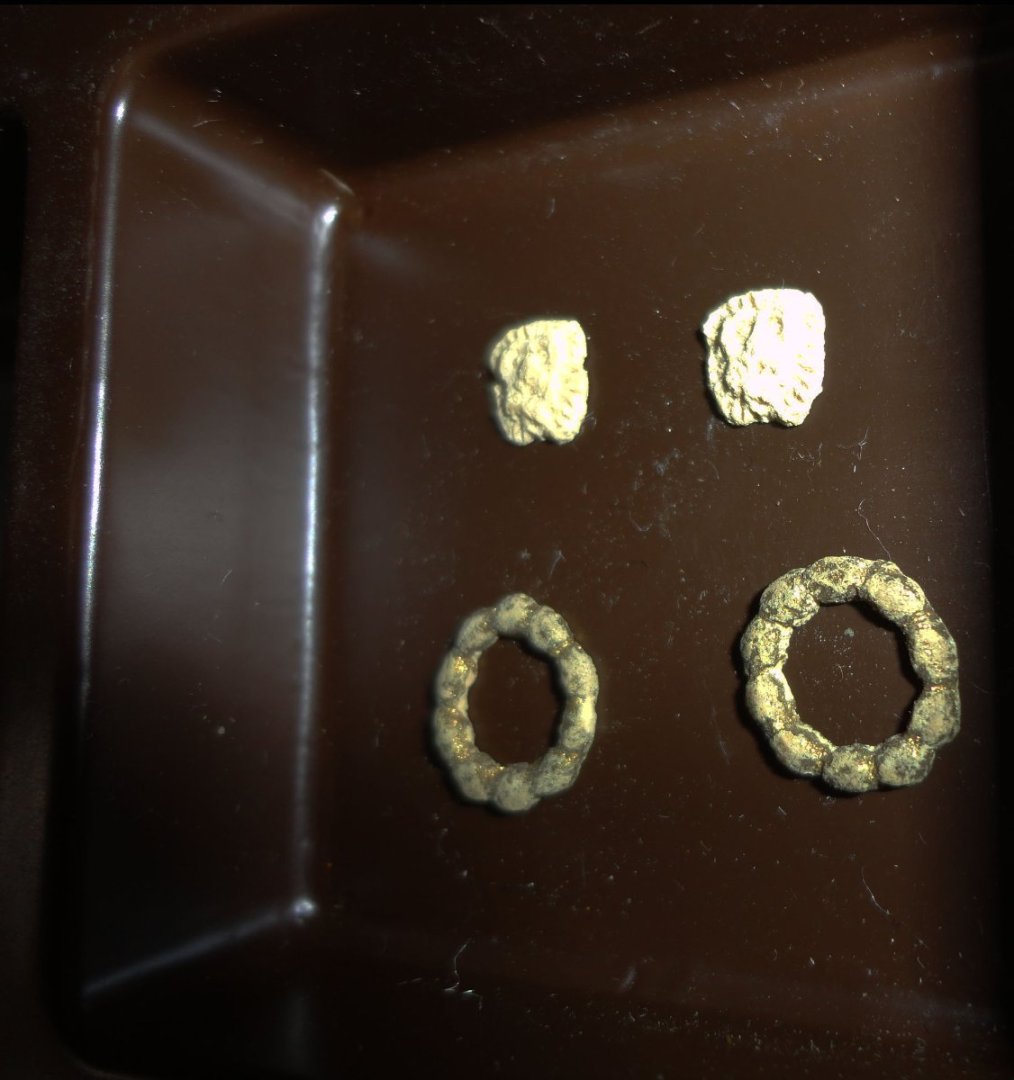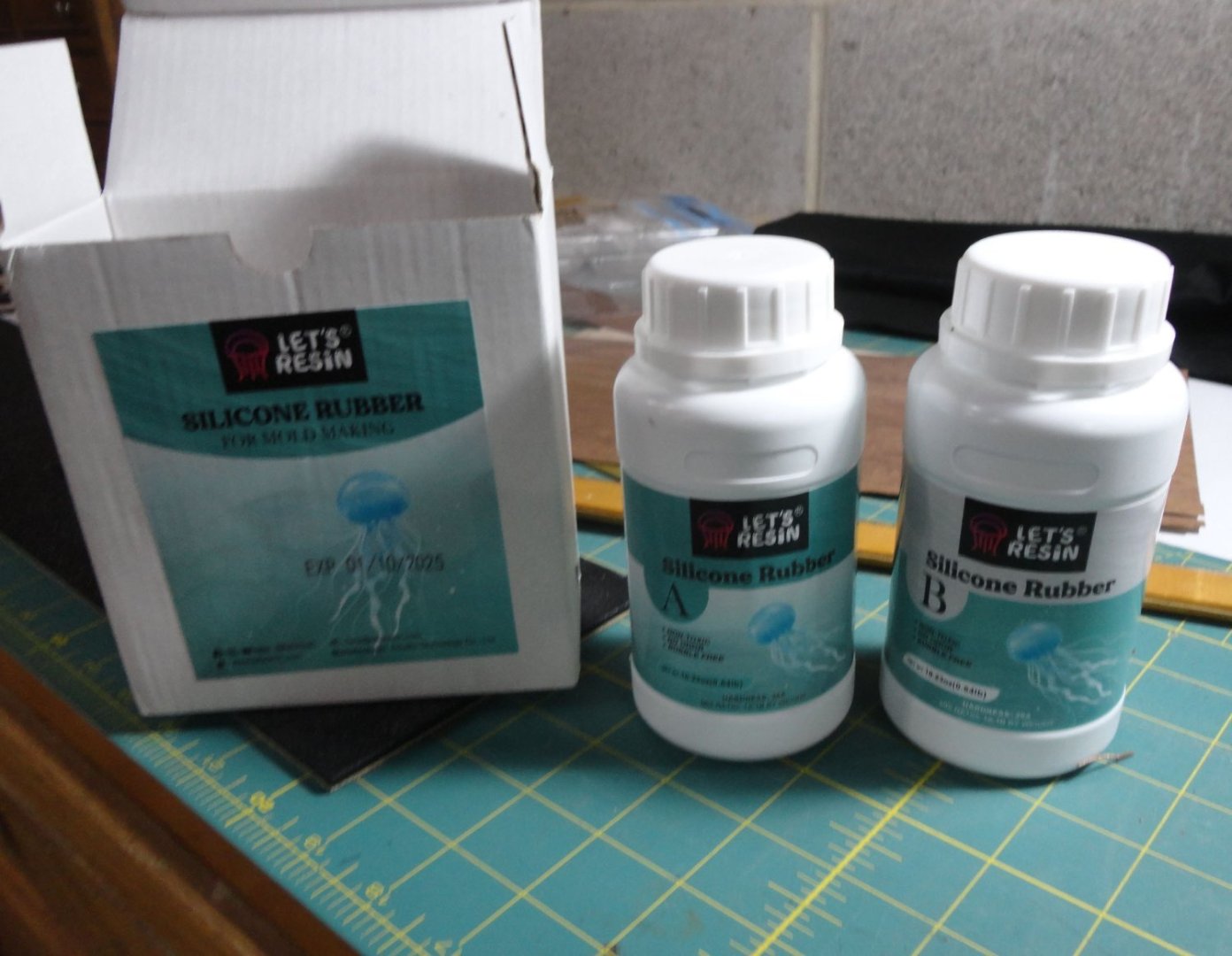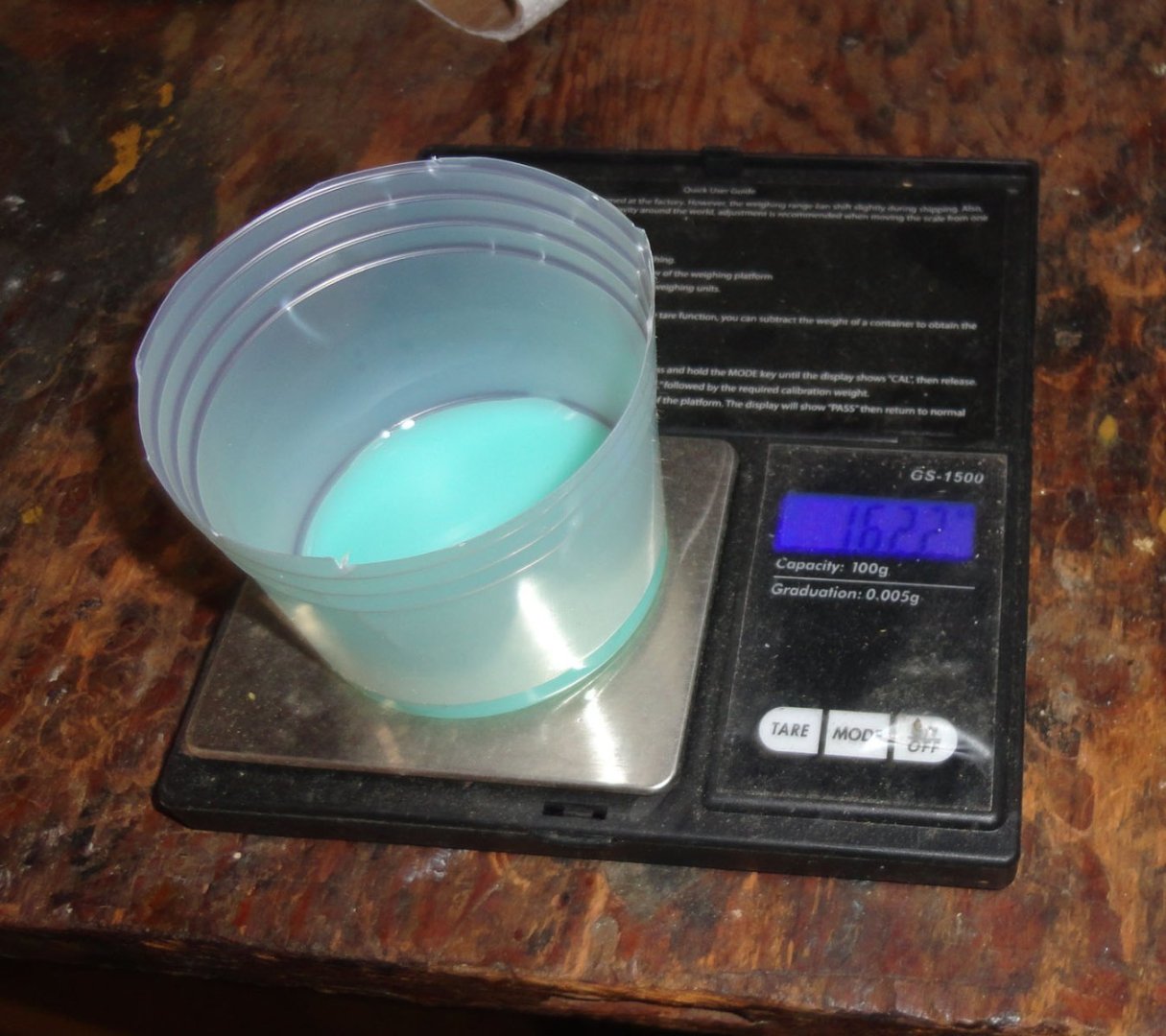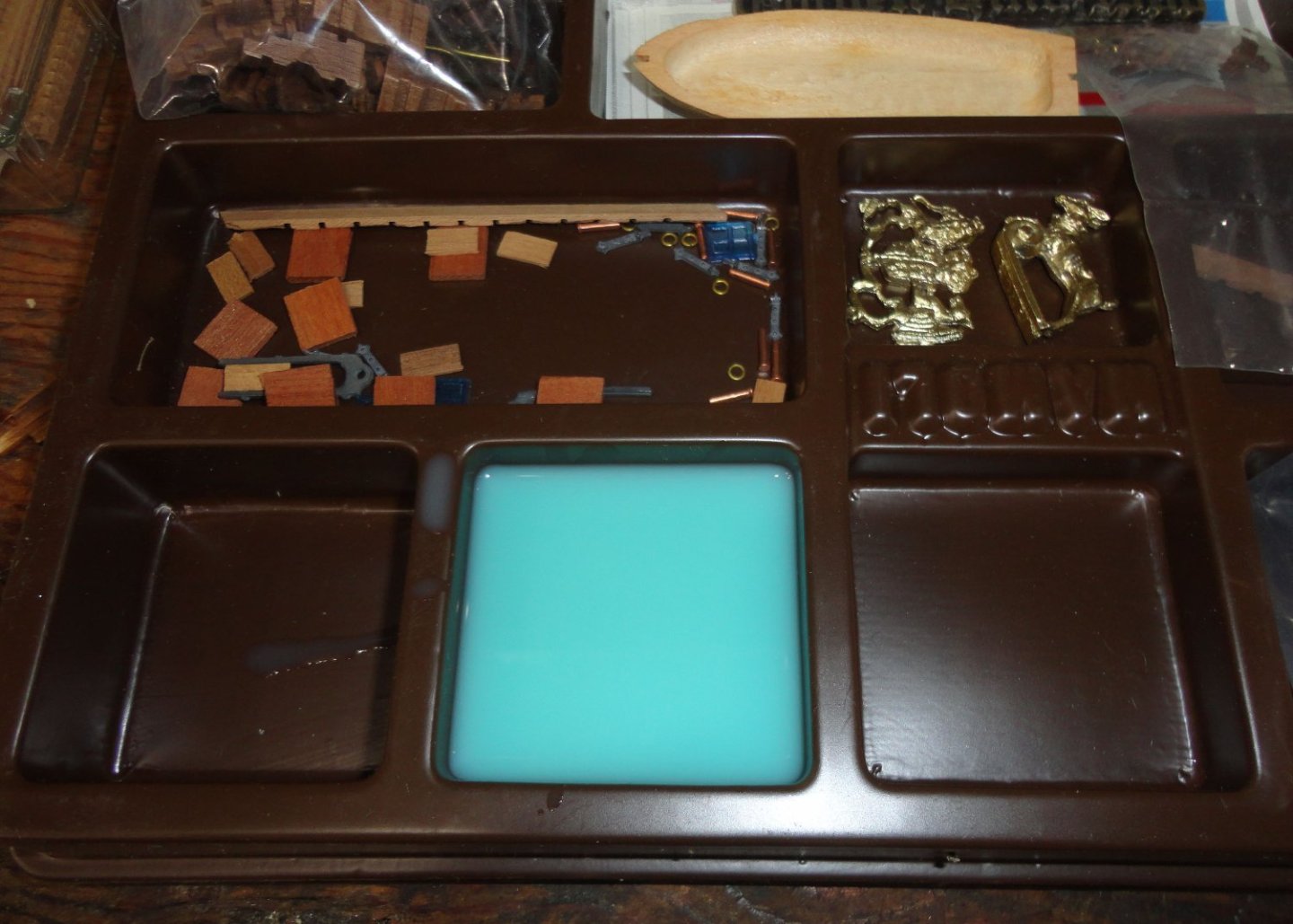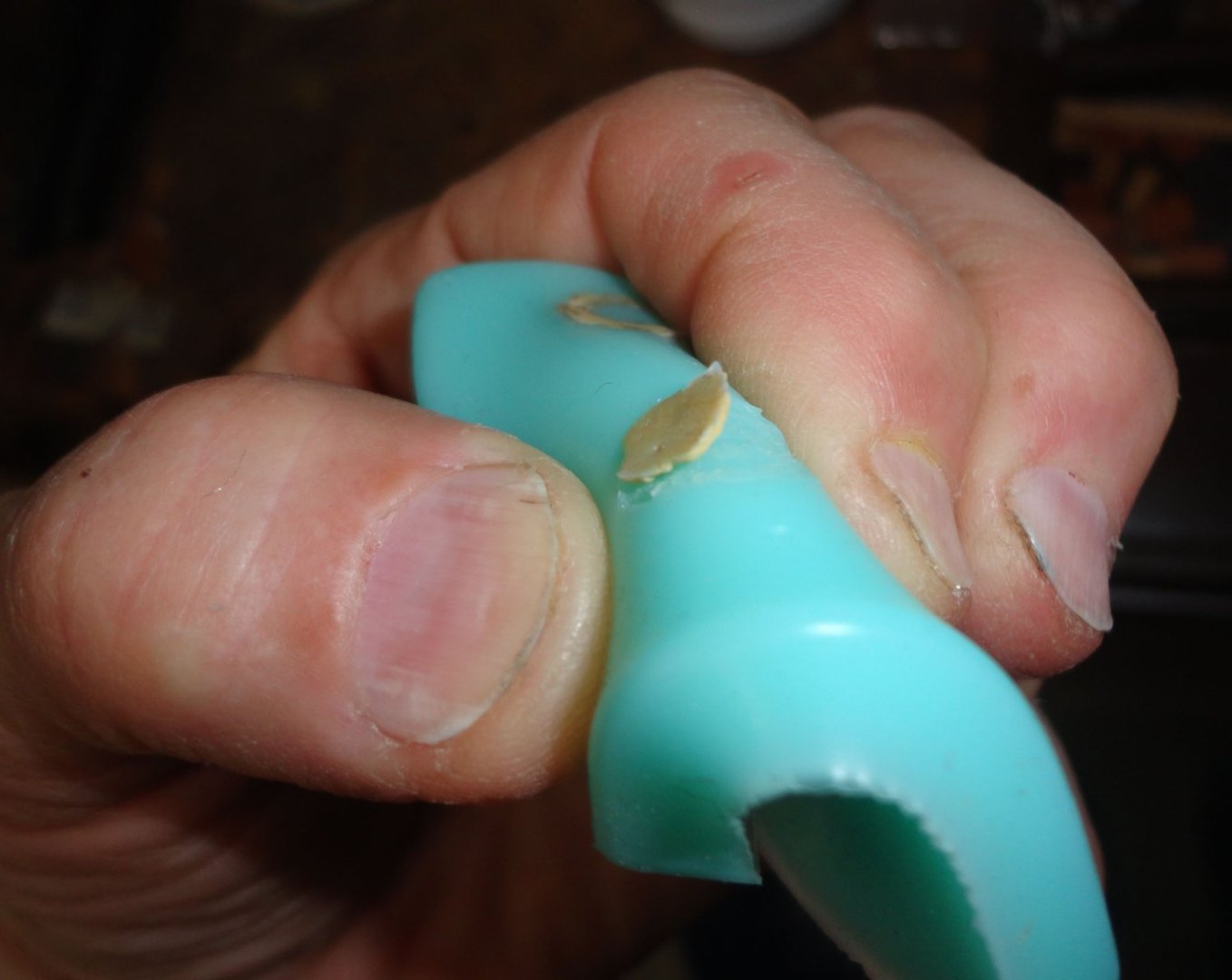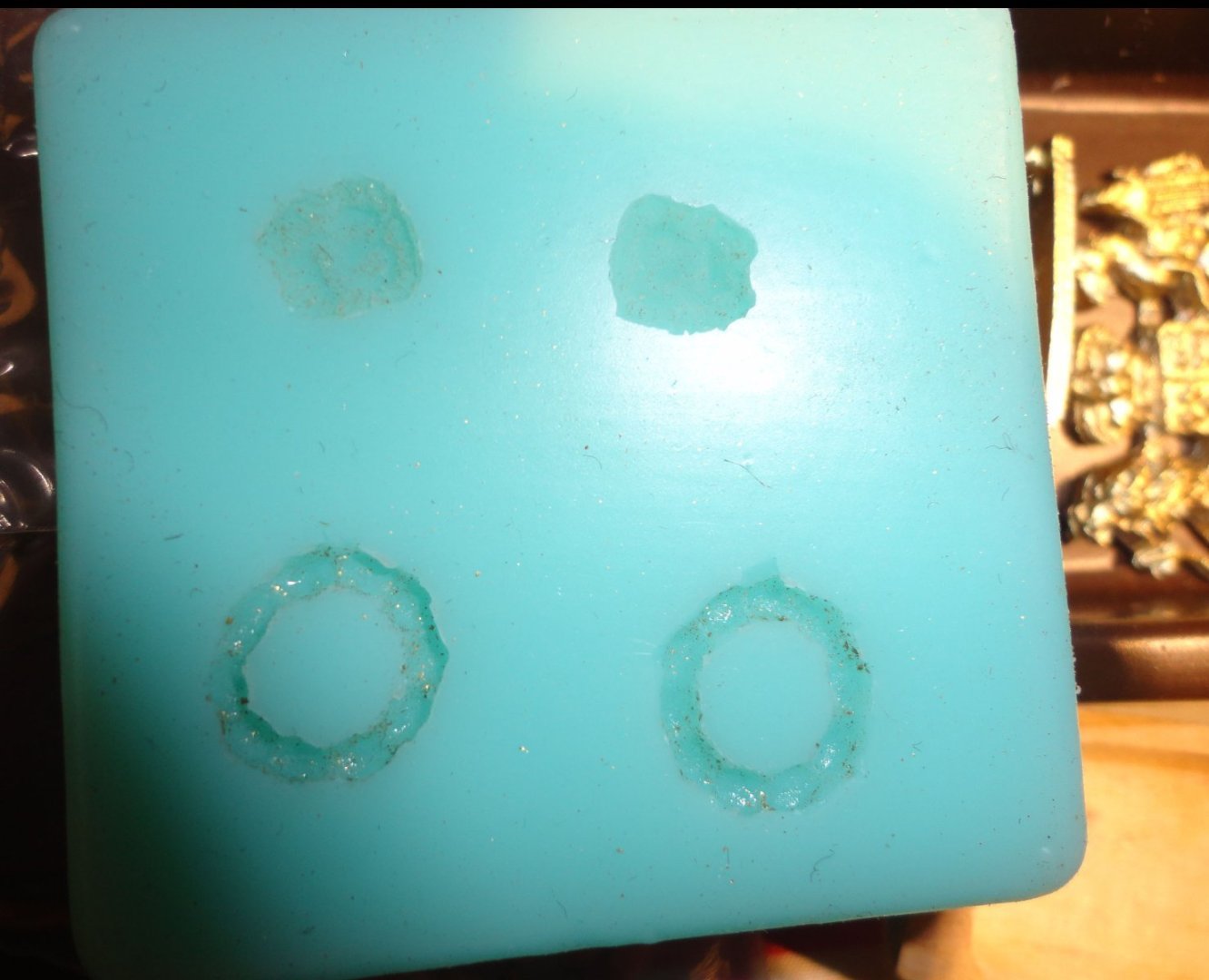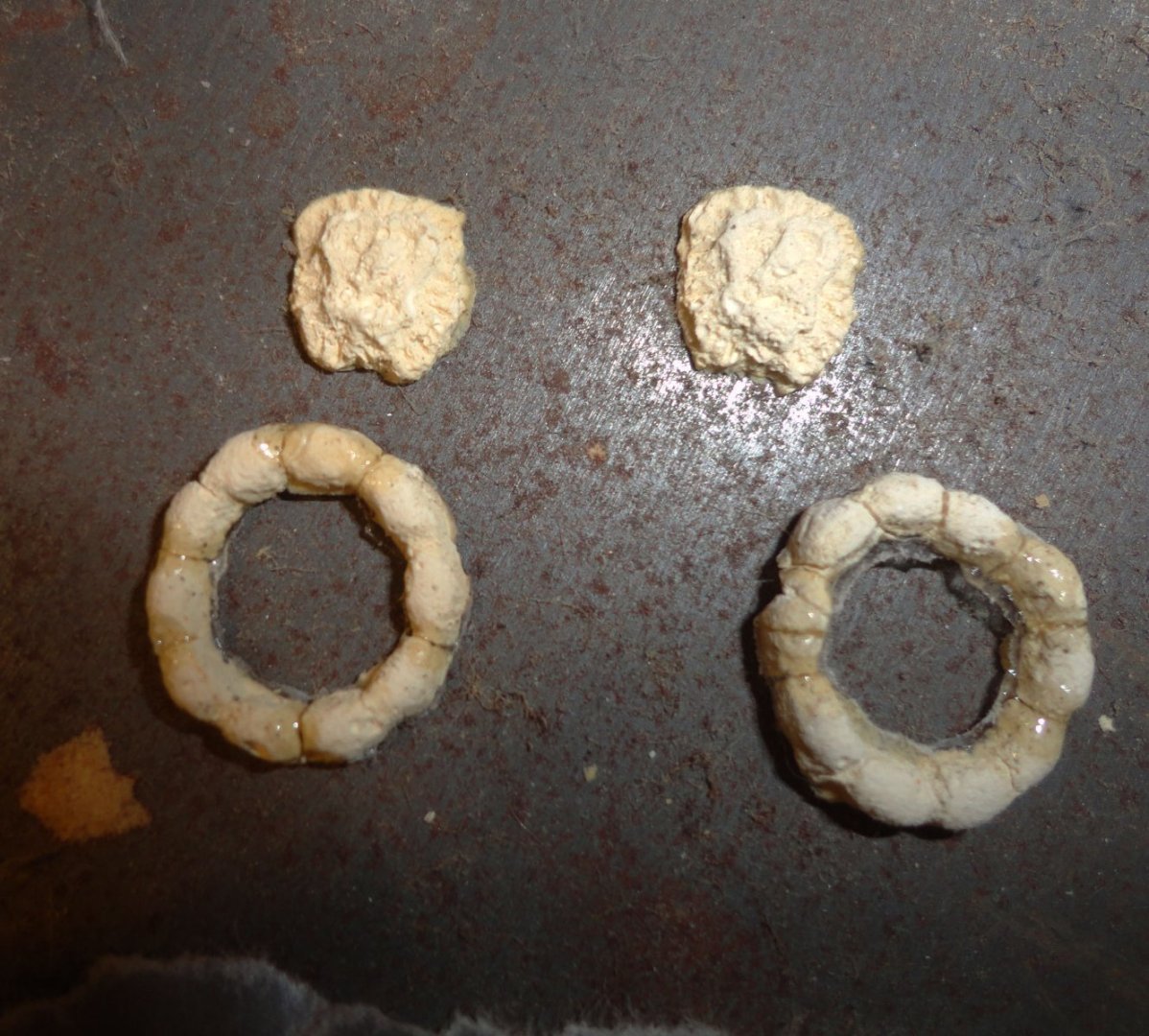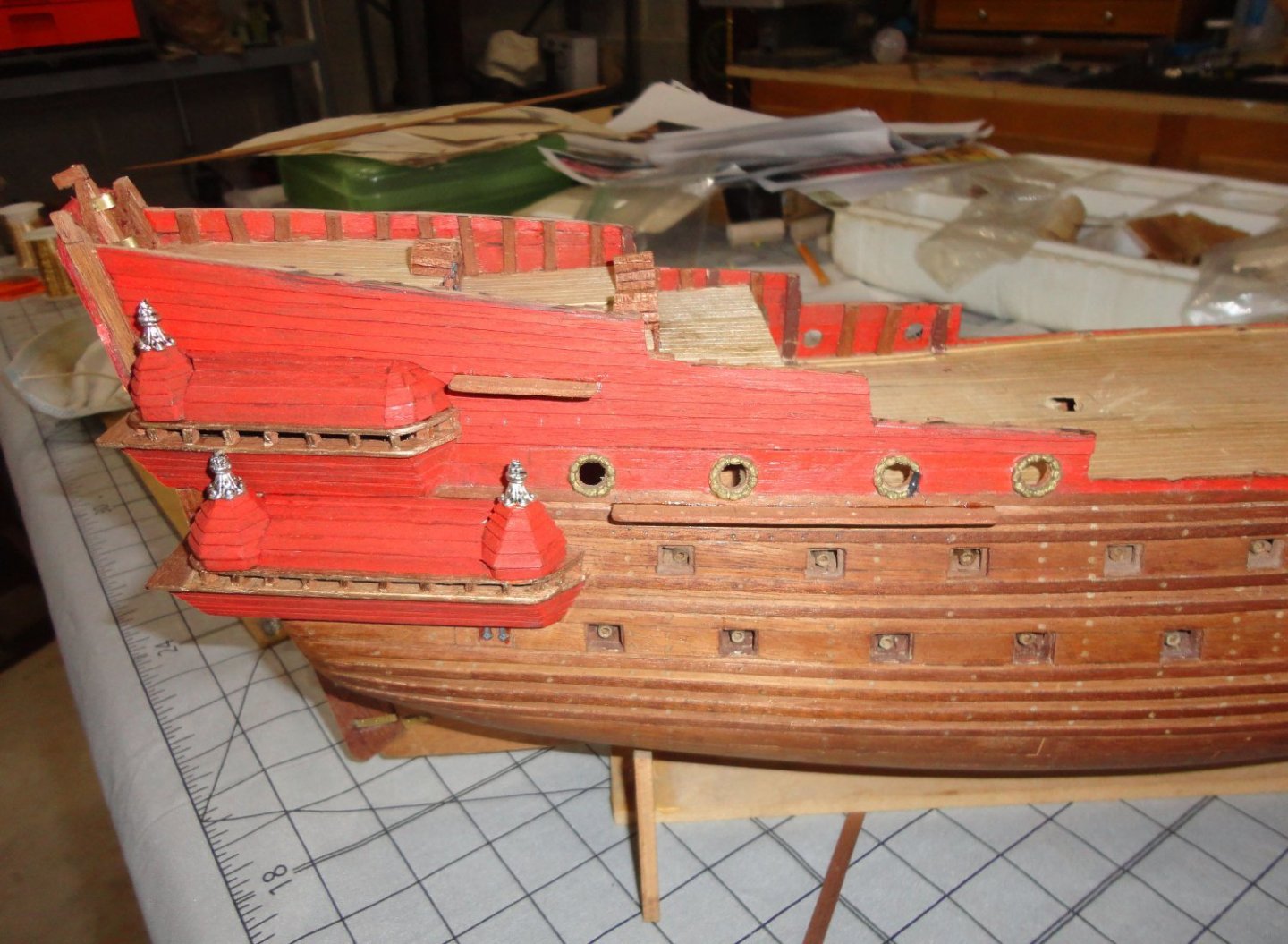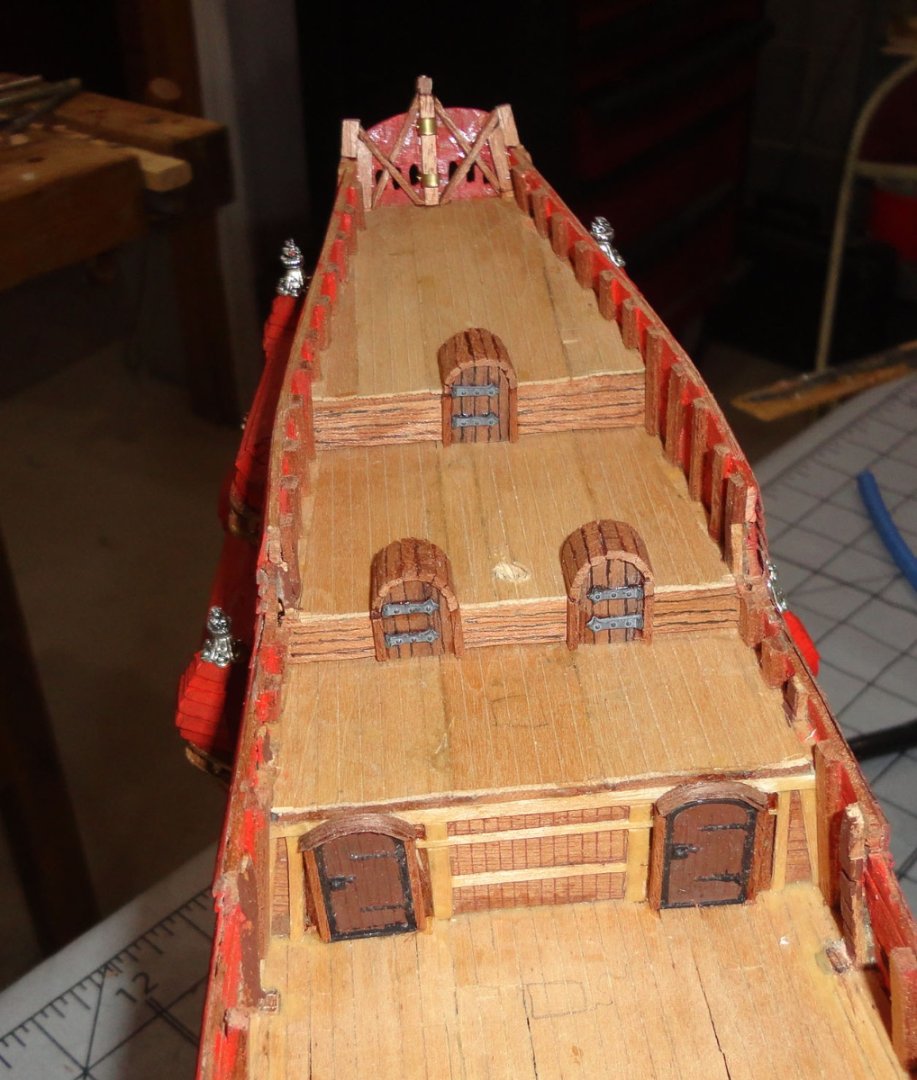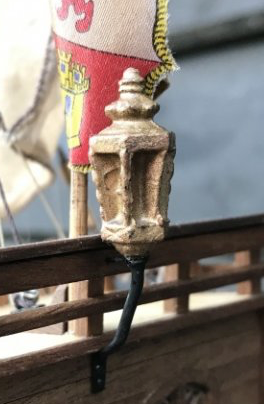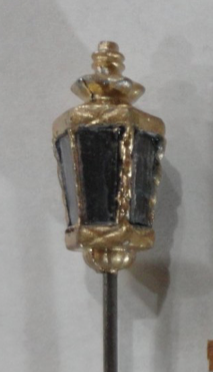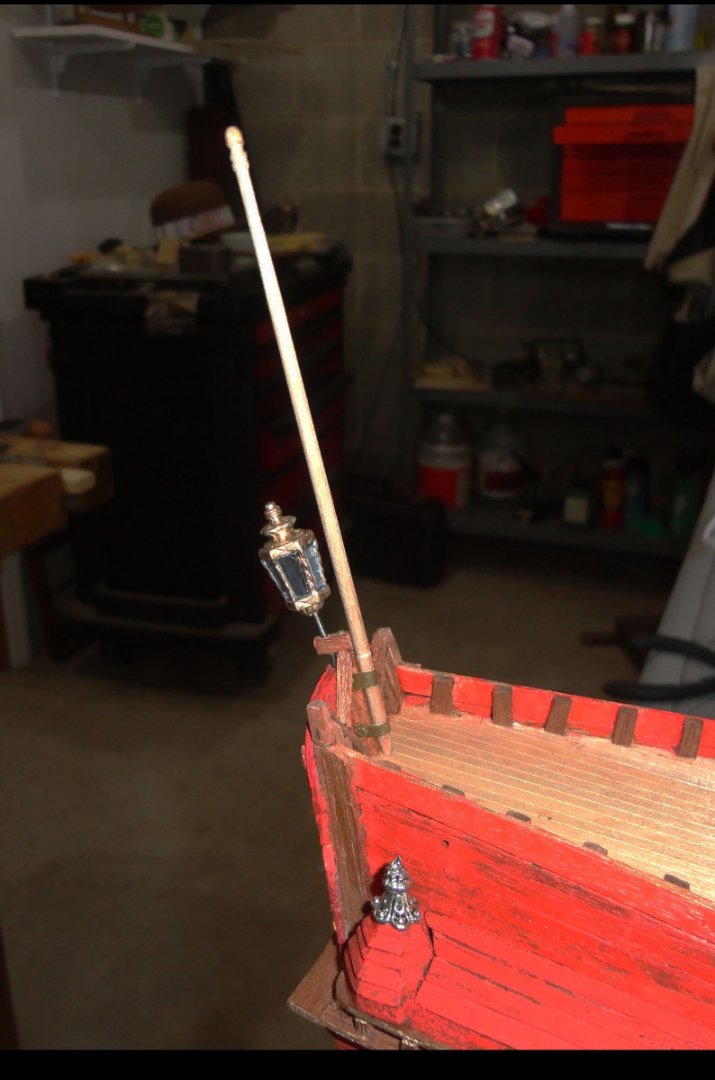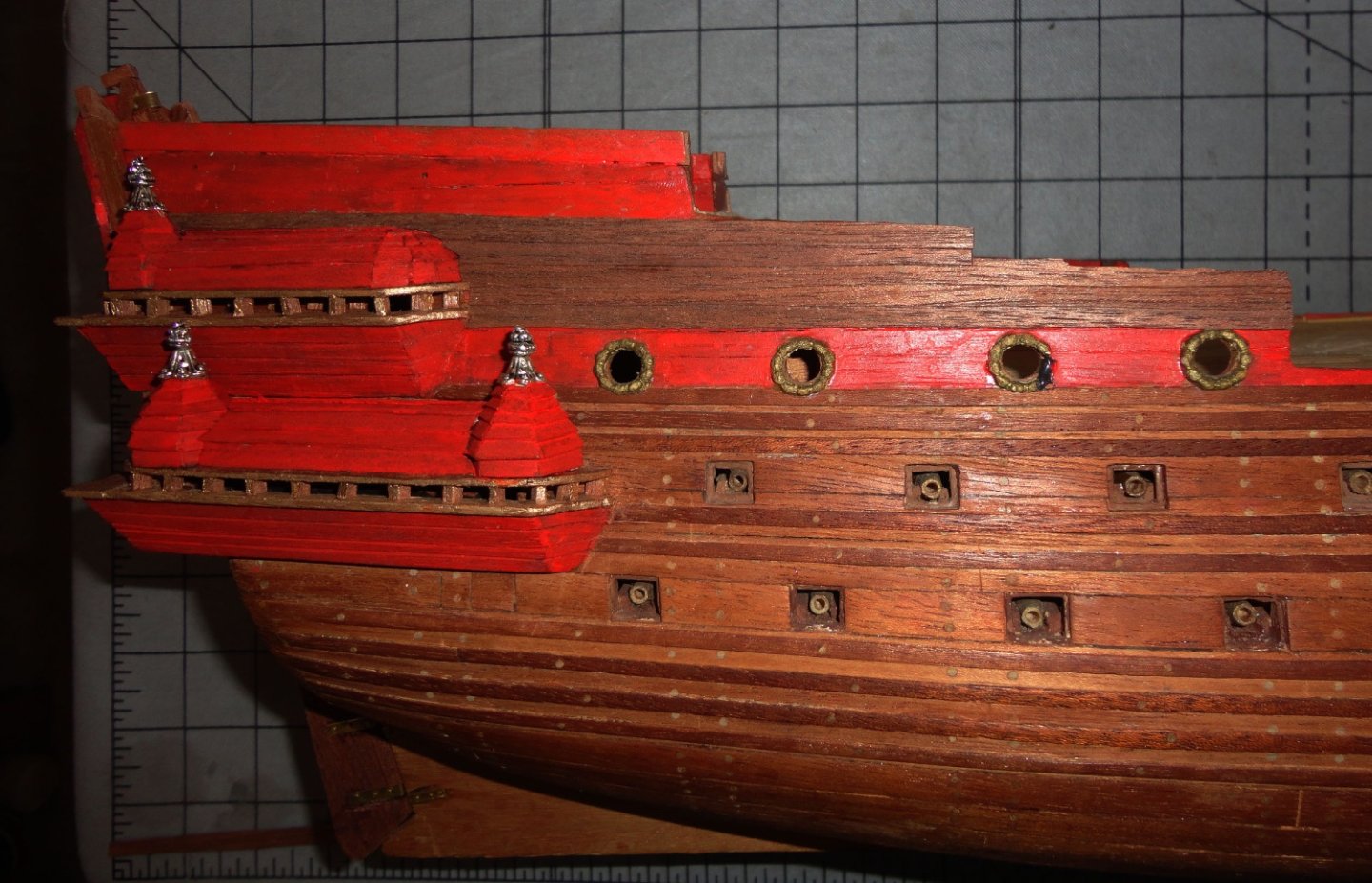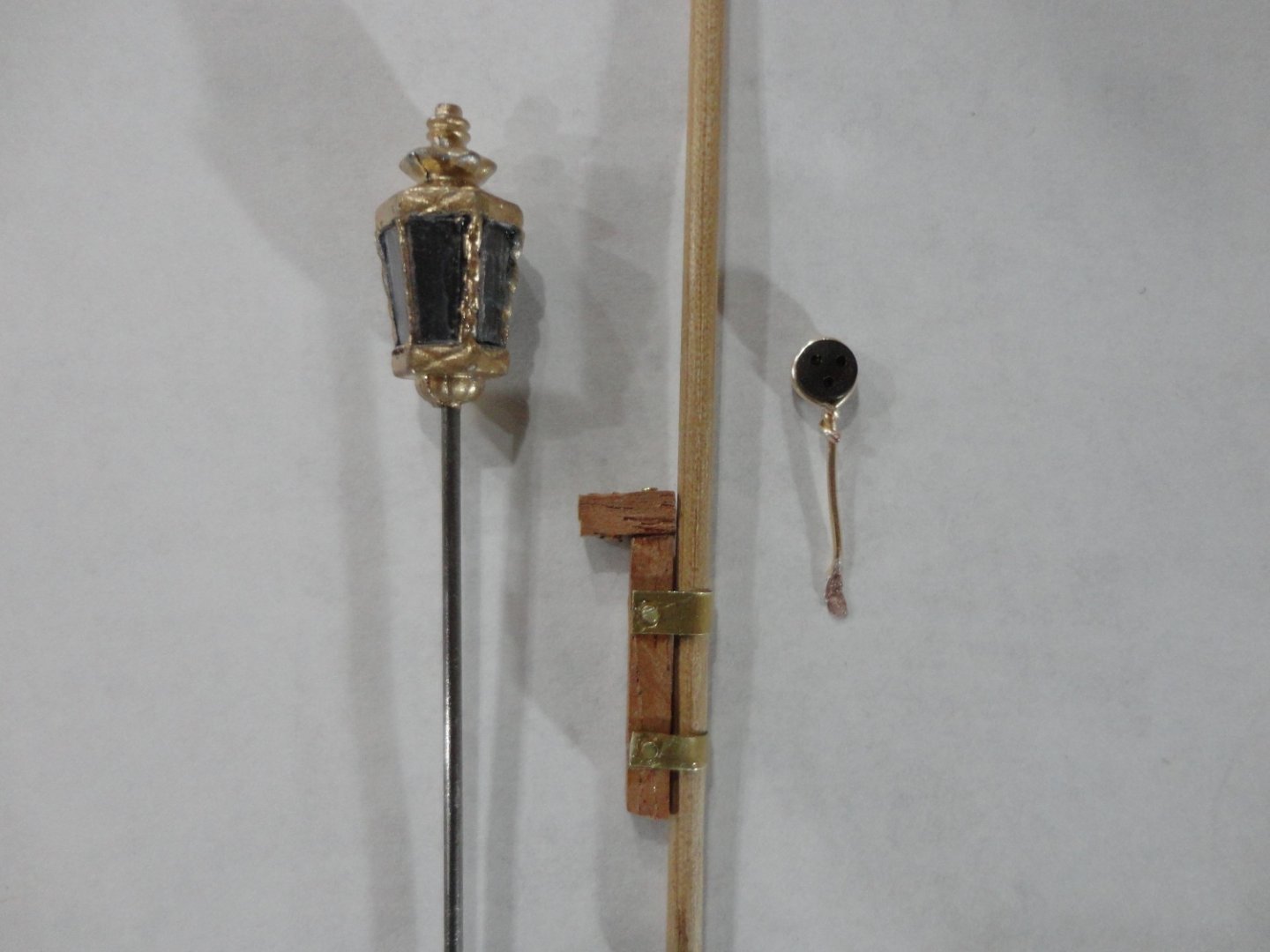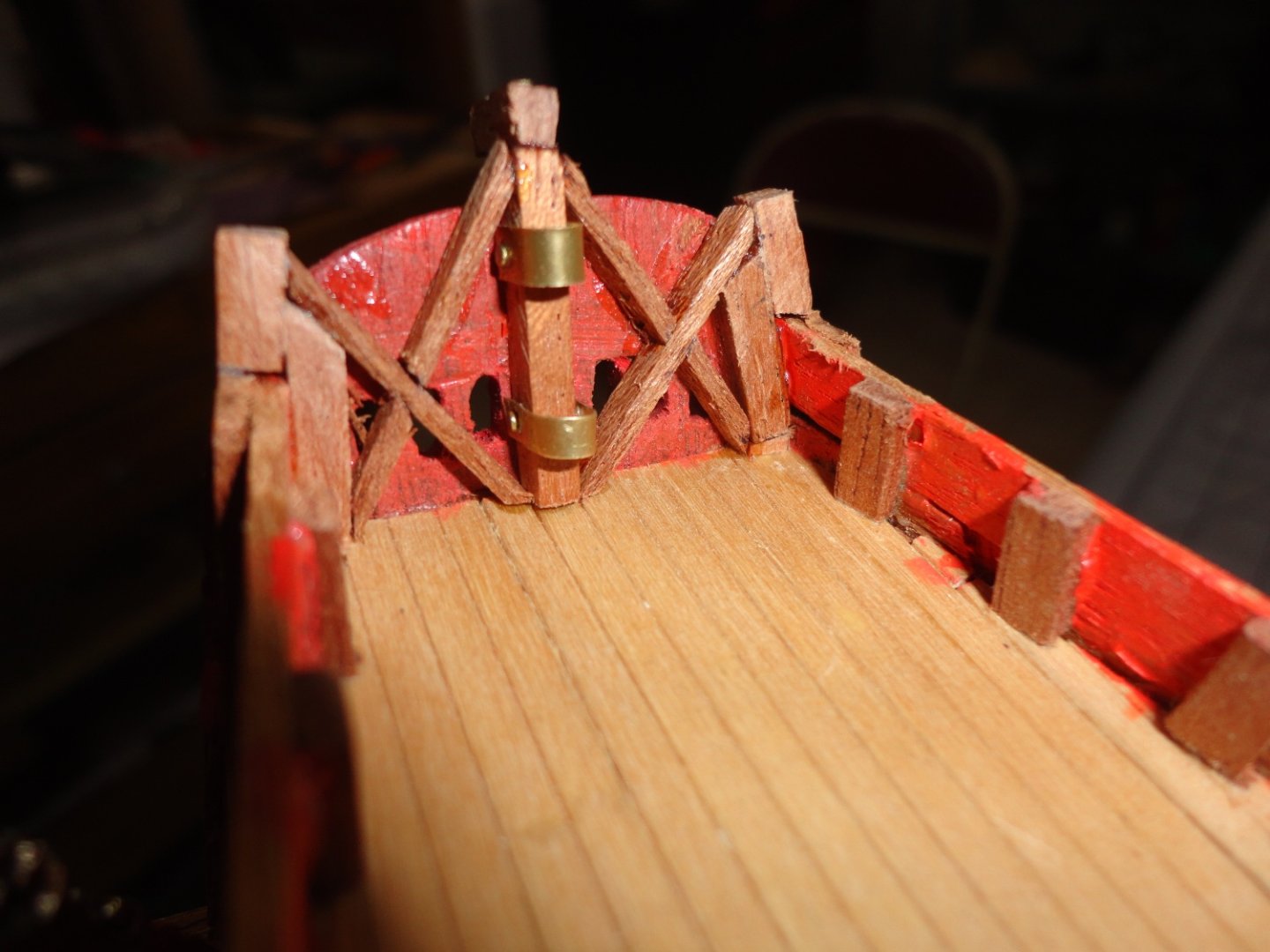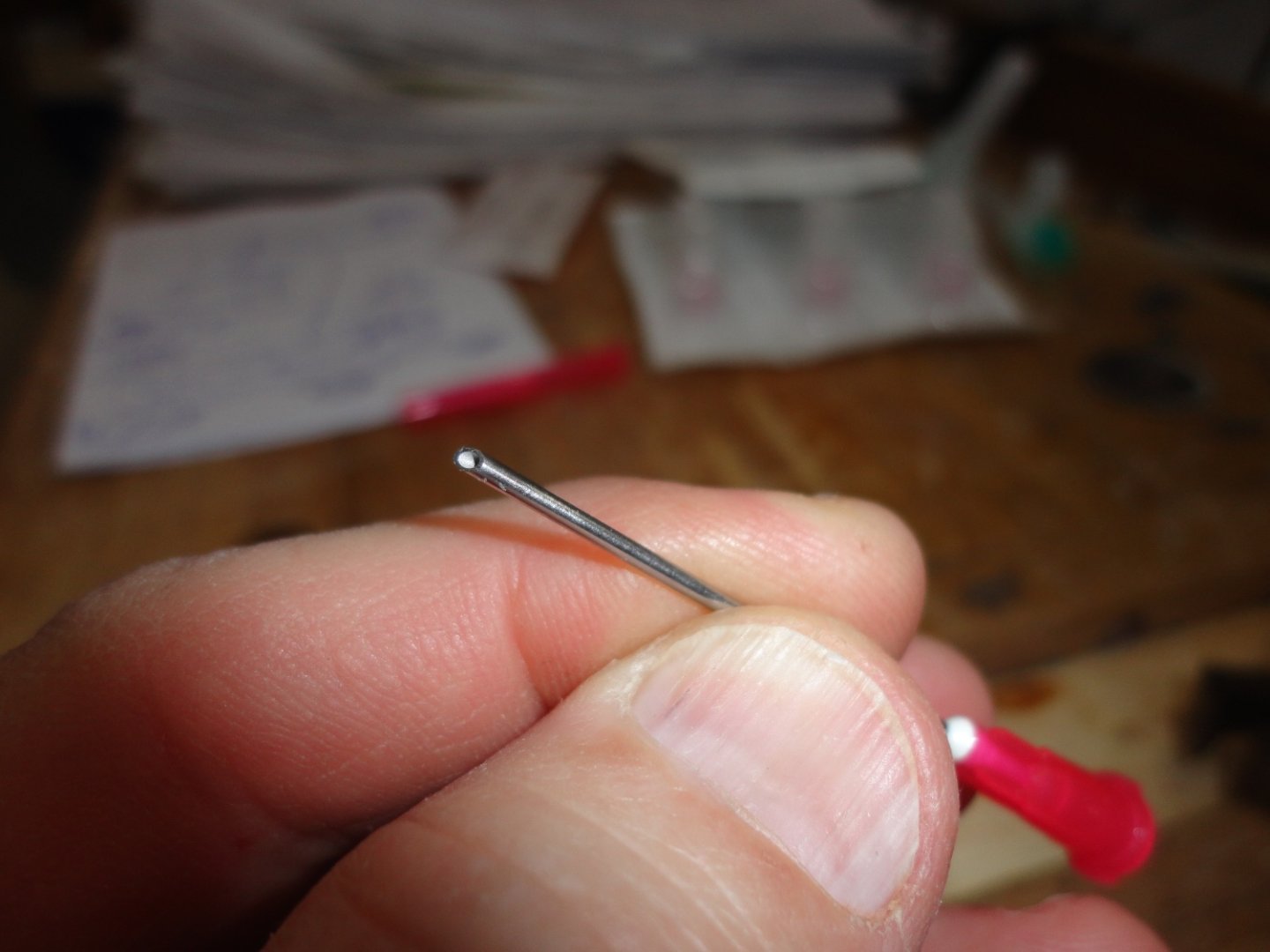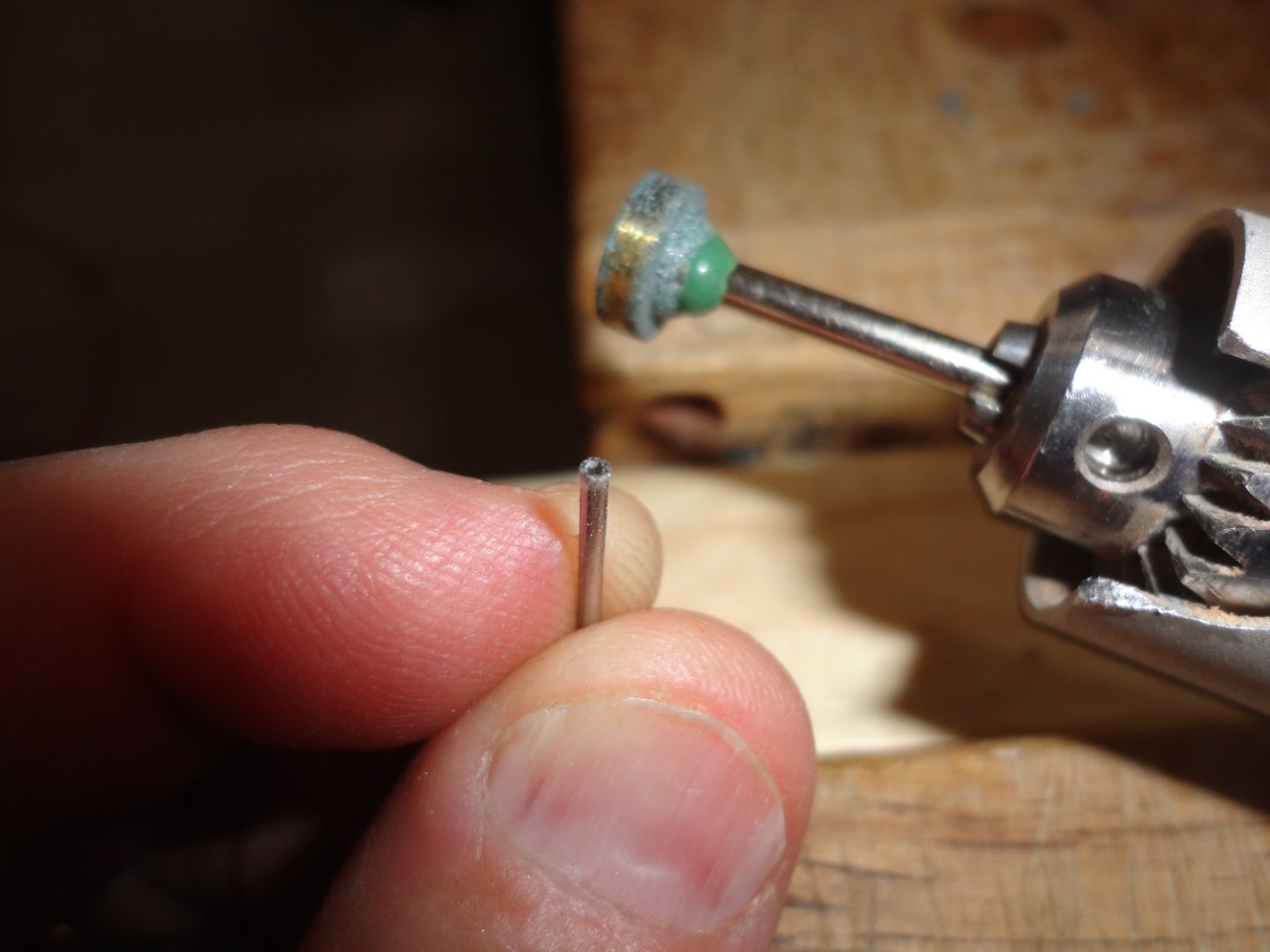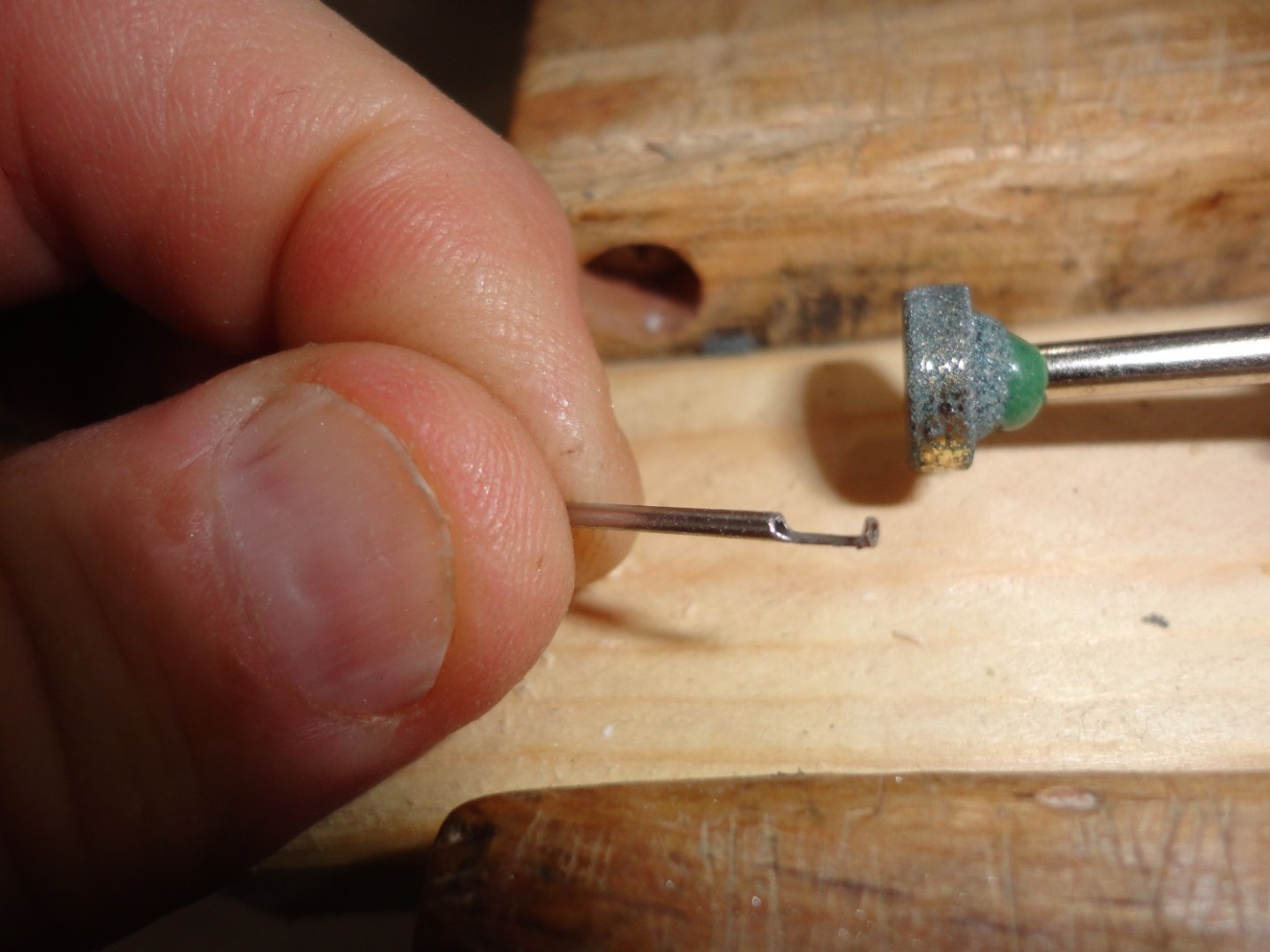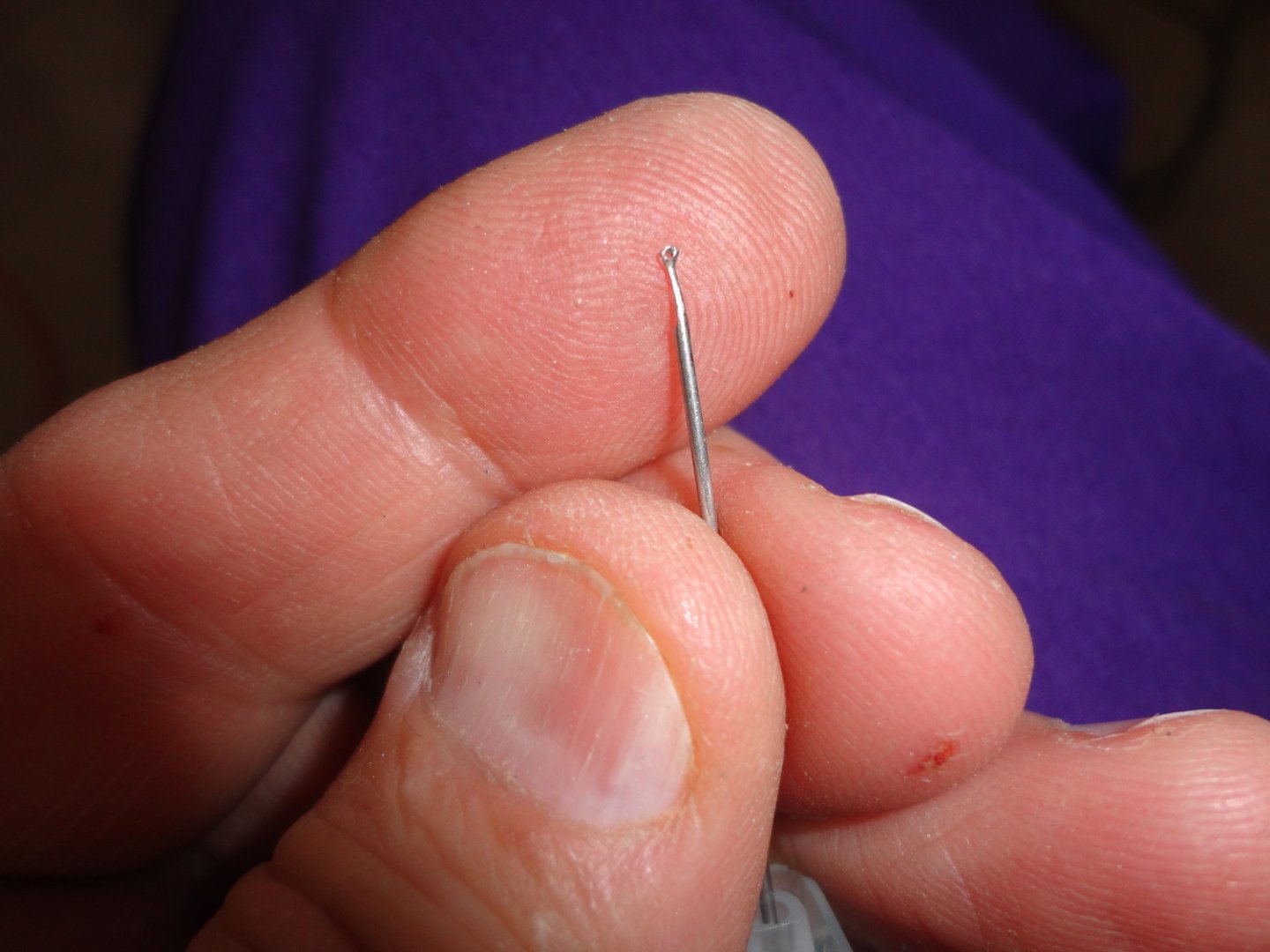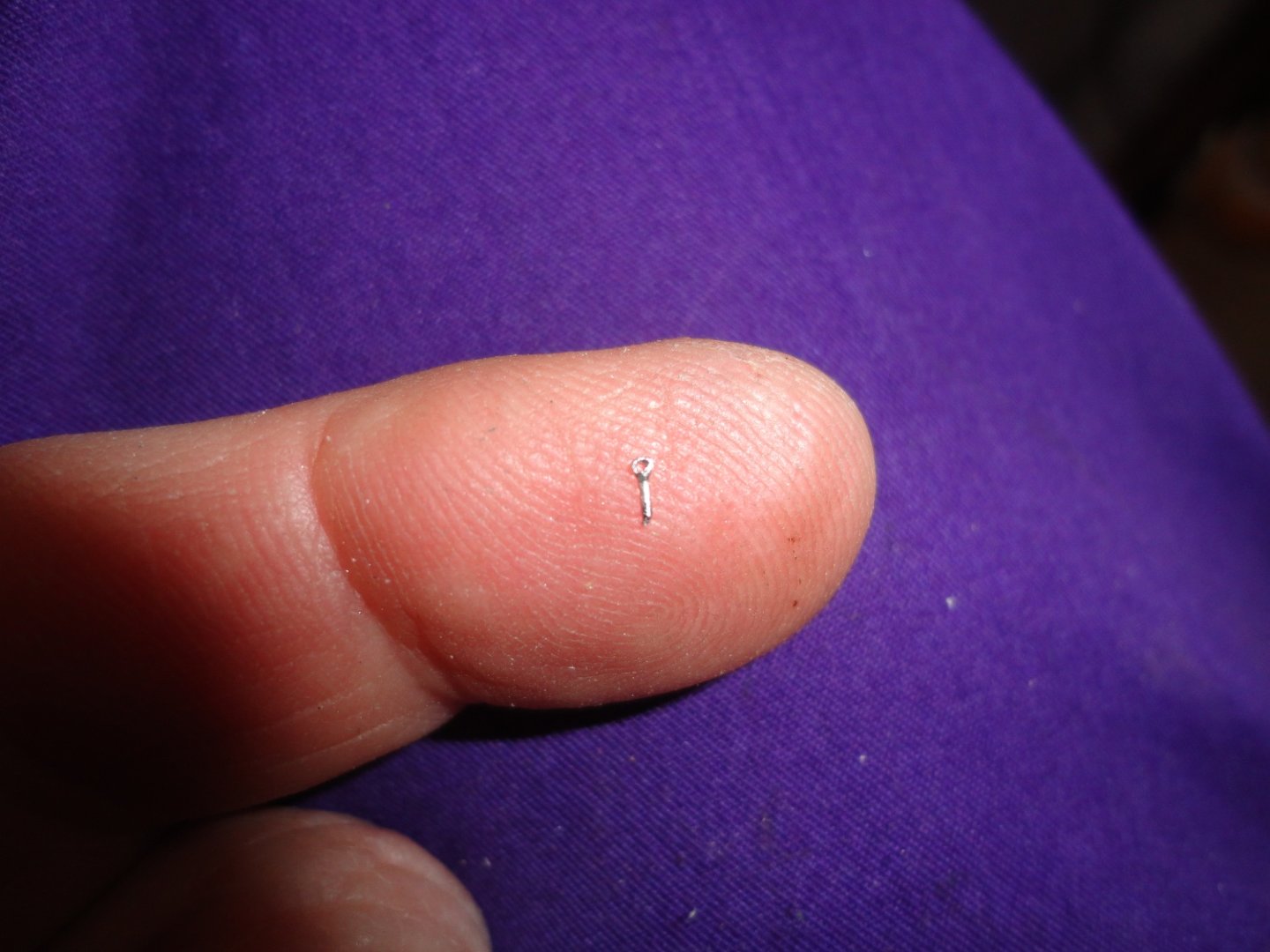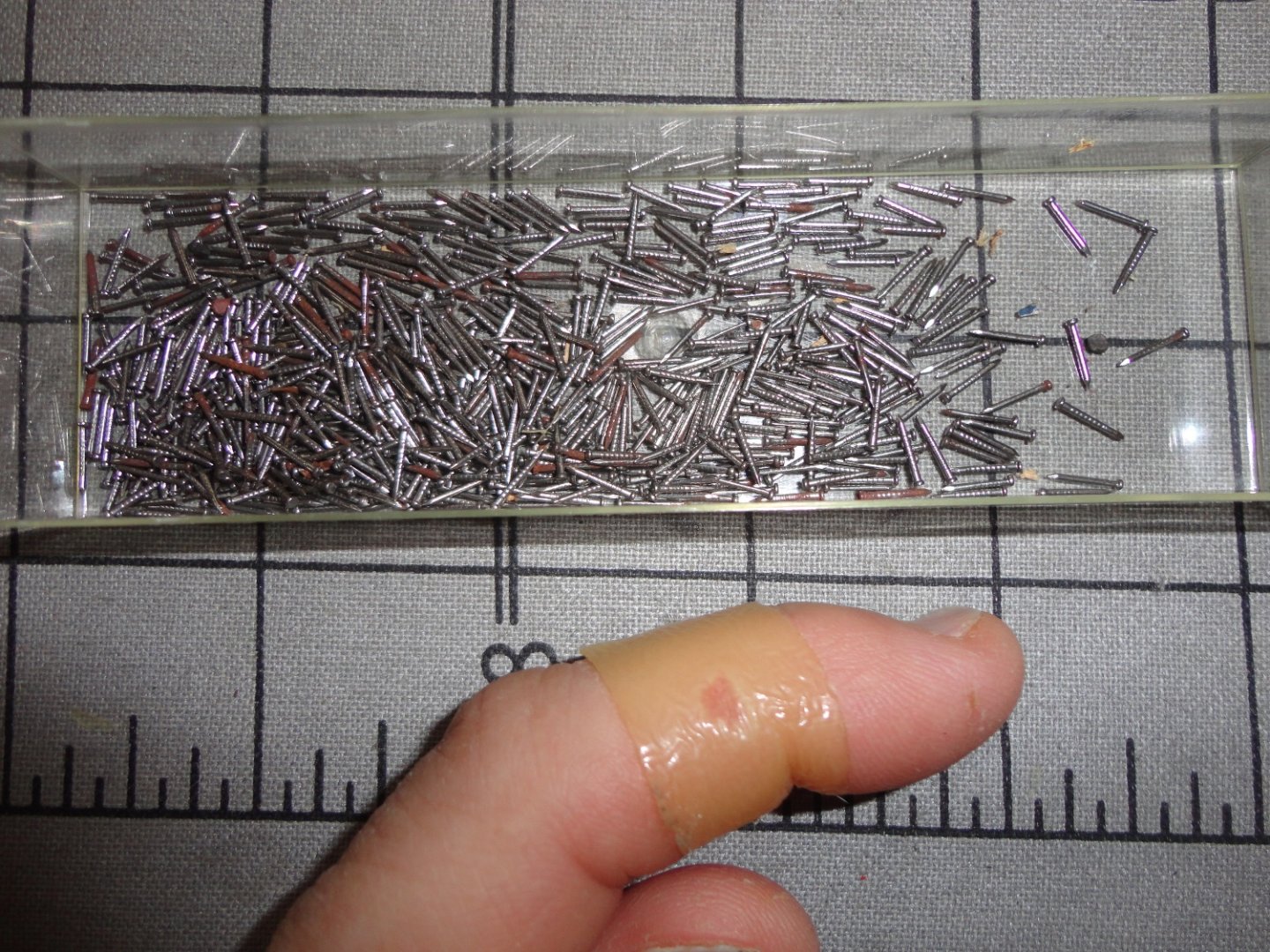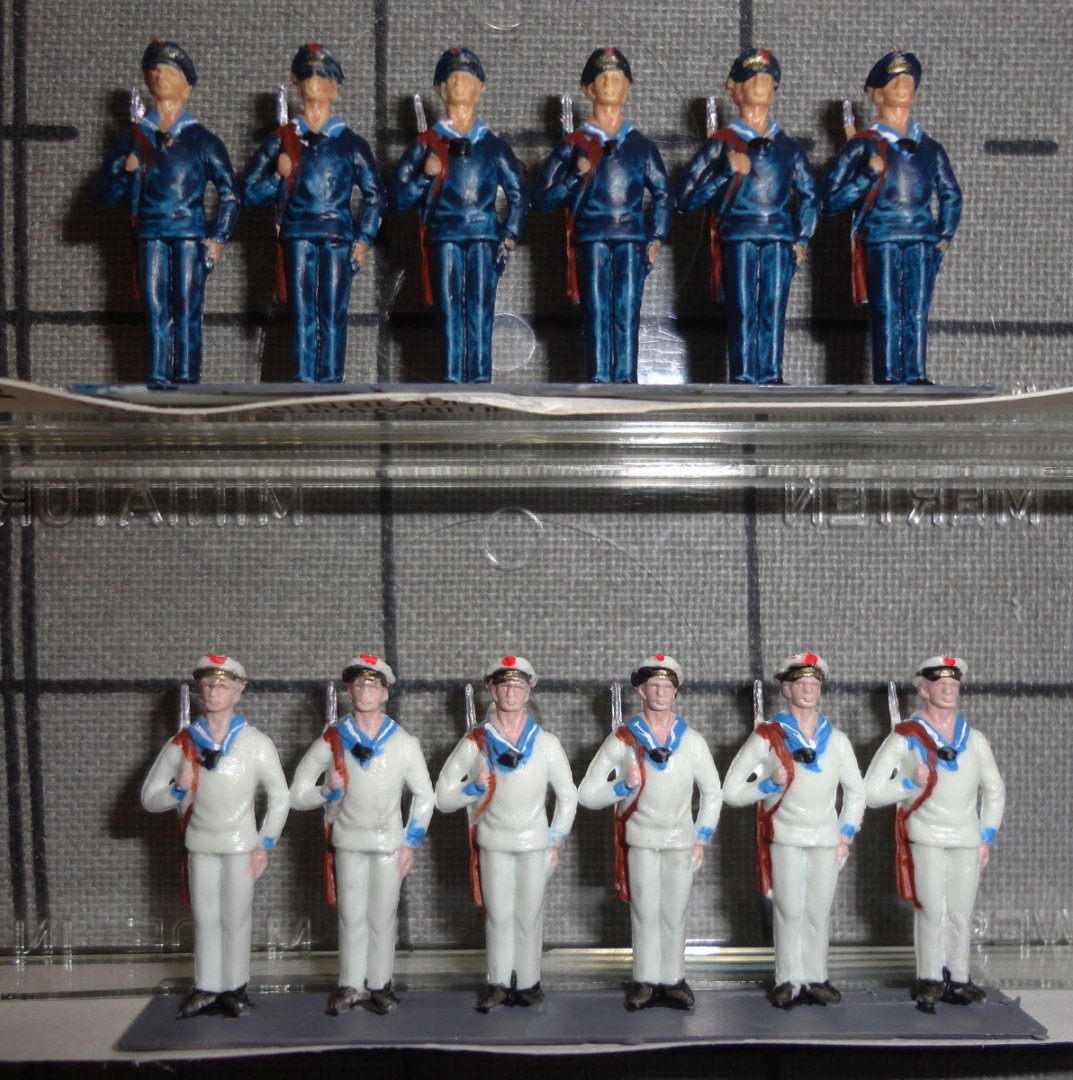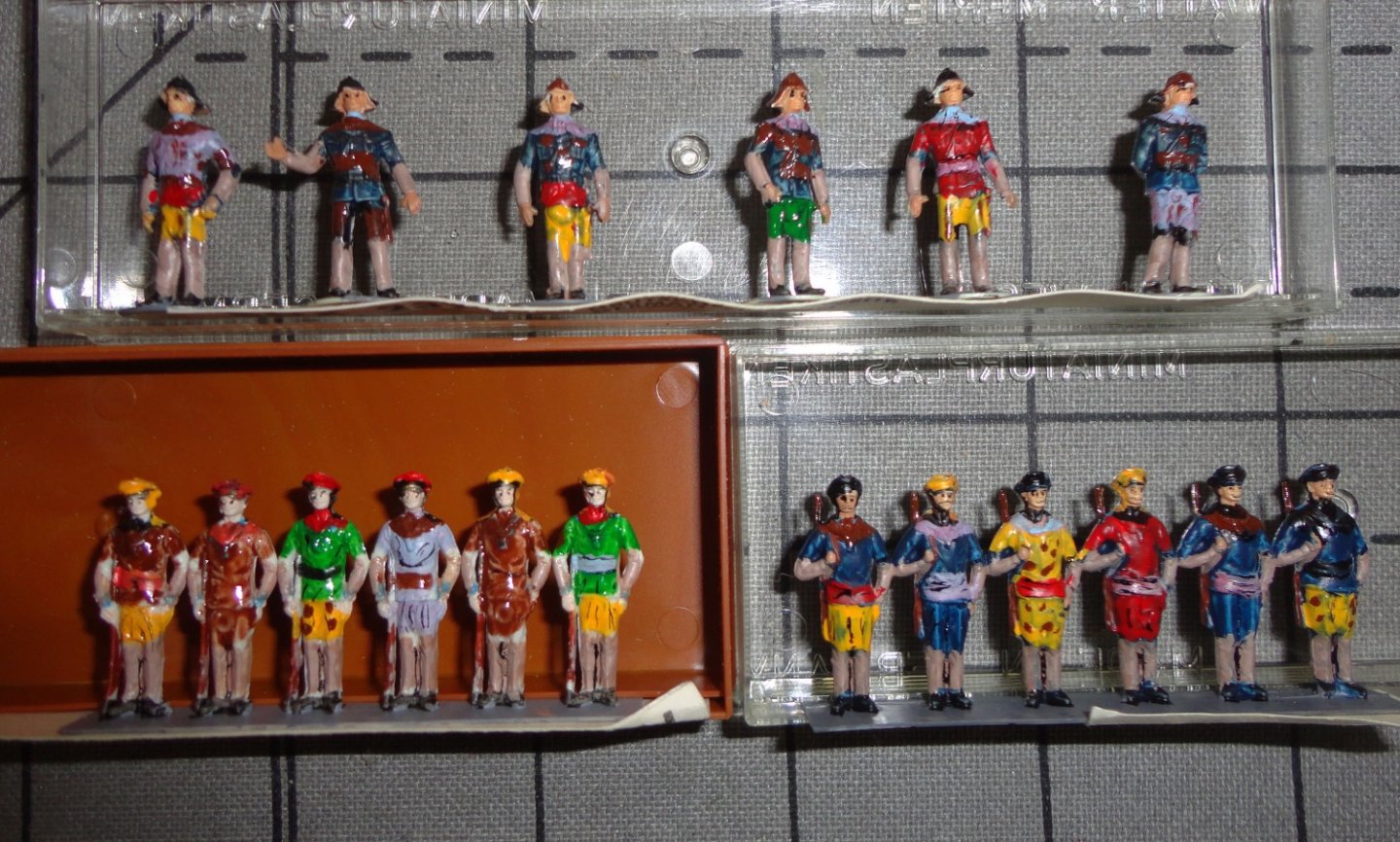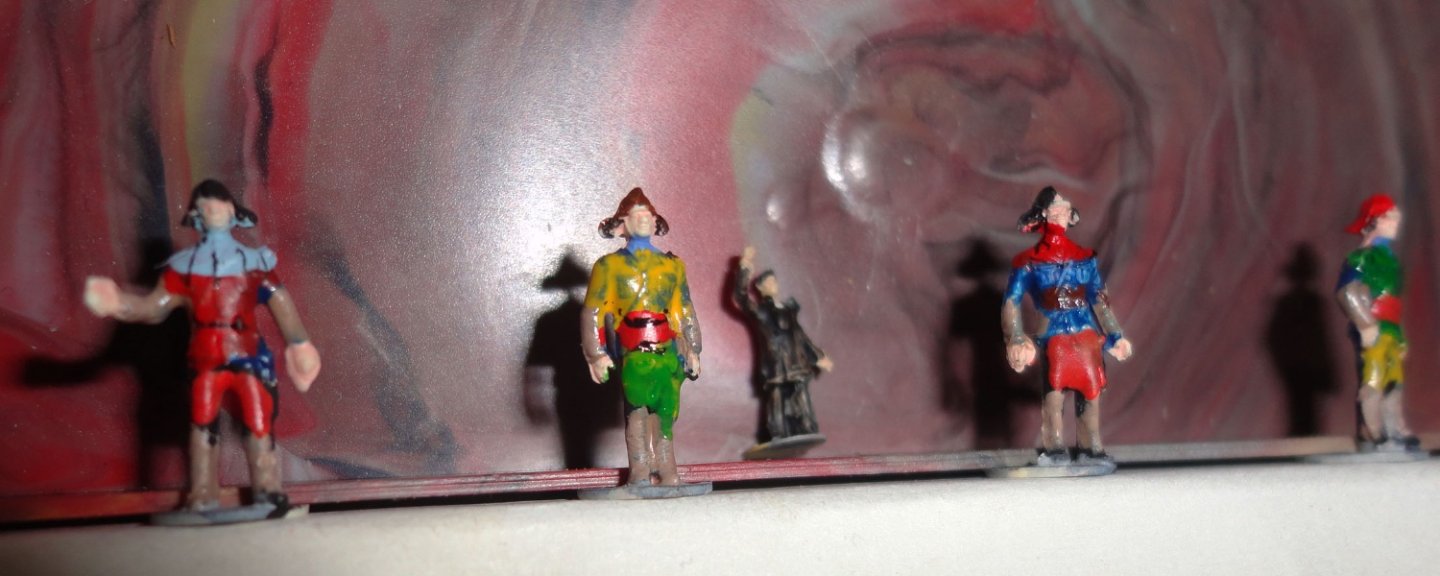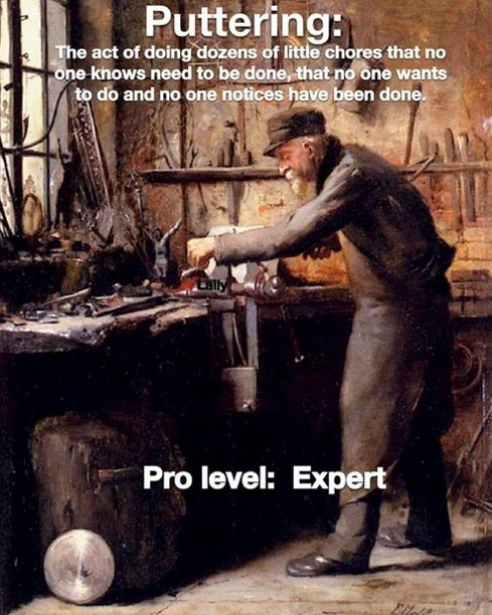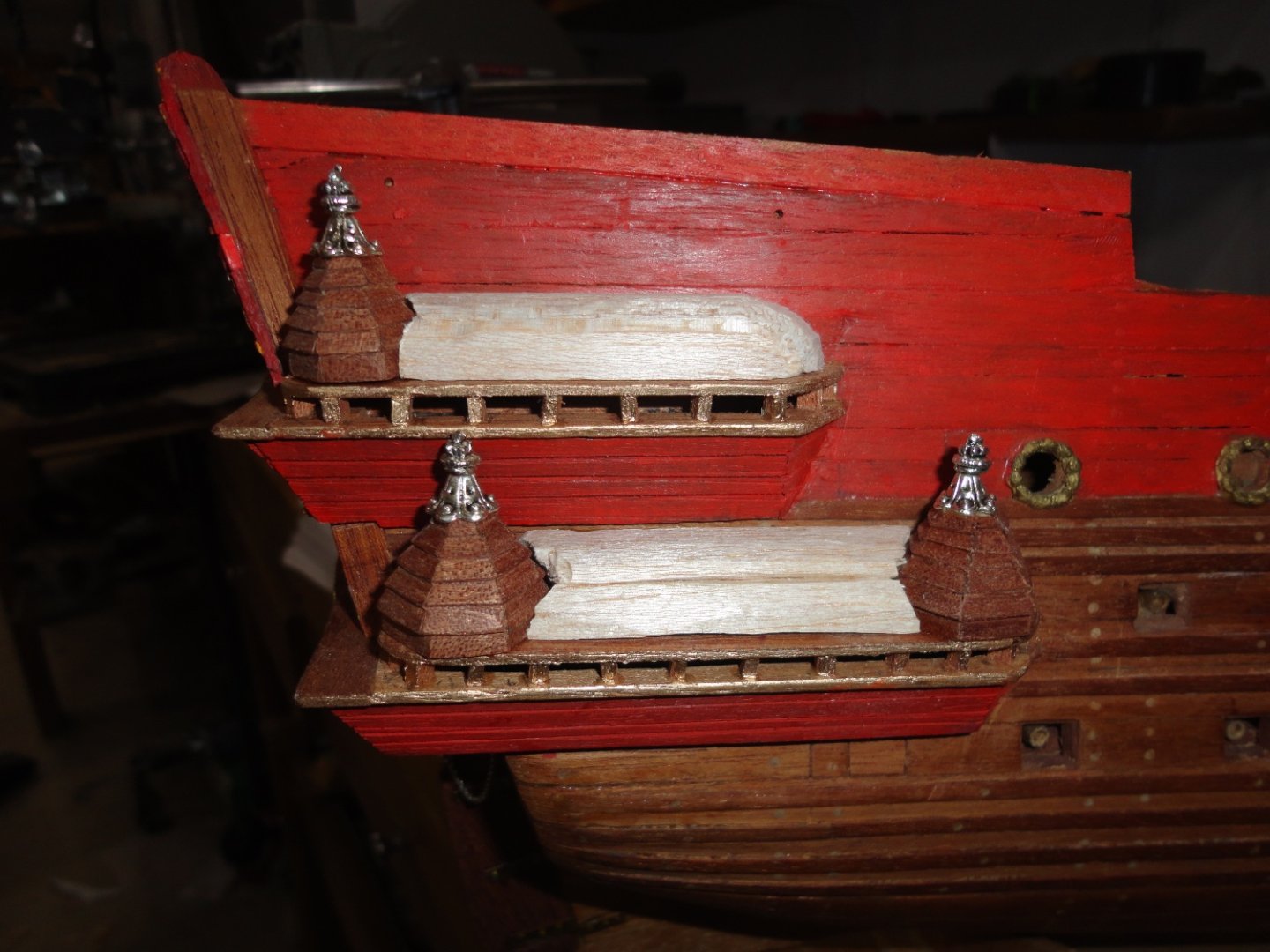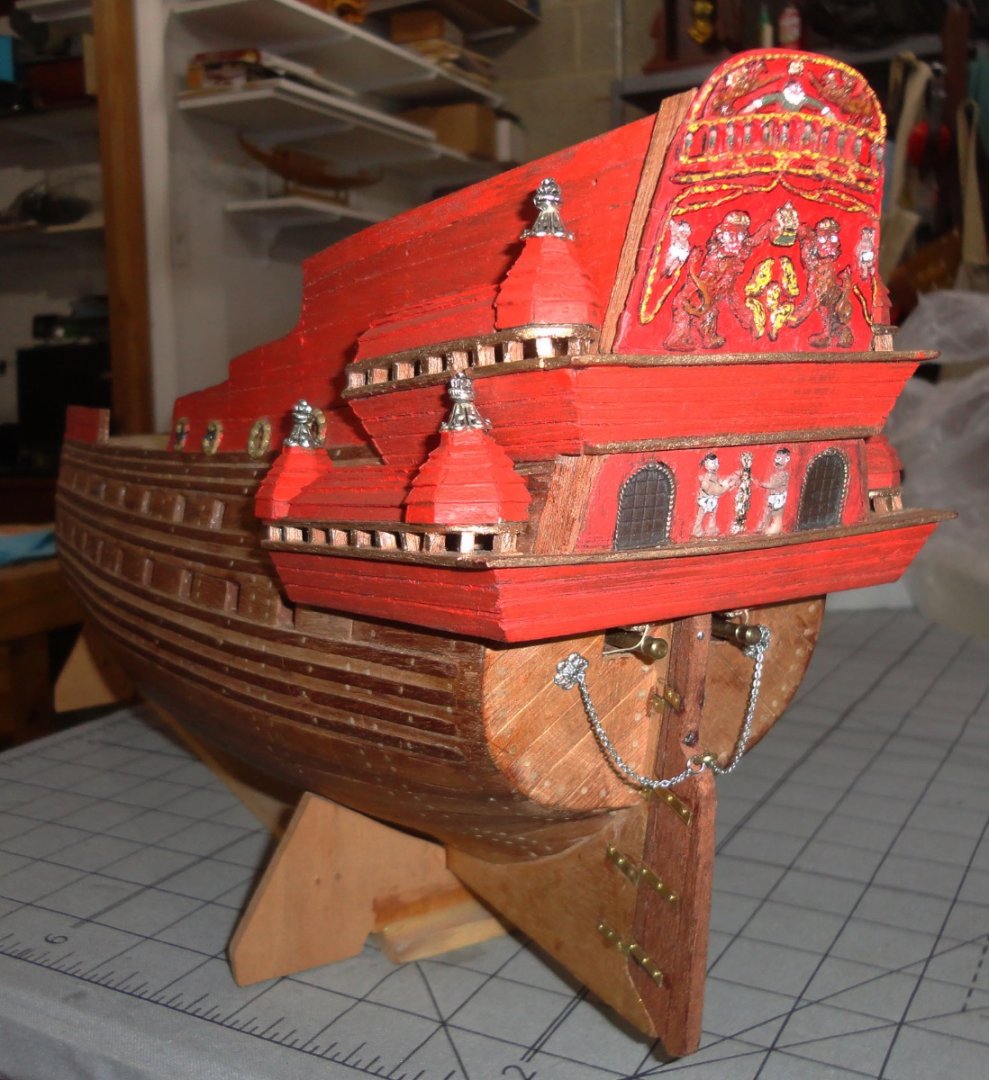-
Posts
1,353 -
Joined
-
Last visited
Content Type
Profiles
Forums
Gallery
Events
Everything posted by Snug Harbor Johnny
-
'Saw a clear demo on the 'sew' method for ratlines (it may have been part of the USS Tennessee log 1:96 scale), The shrouds/deadeyes are done first, of course (and some save the ratlines for last to make other rigging easier). A sewing needle is used to pull ratline thread through the shrouds (with paper marked for horizontal ratline spacing fastened with clips behind the shrouds) from whichever side one is comfortable starting with (RH vs LH). Then everything is adjusted, and after all ratlines are in place and tweaked, a tiny bit of one's glue of choice fixes all the joints (thinned PVA vs CA), with the very ends clipped close with flush cutters.
- 248 replies
-
- Cutty Sark
- Revell
-
(and 2 more)
Tagged with:
-
'Realized that I need a few more tiny lion heads and round gunport surrounds - and the old latex molds crumbled with age. Not finding liquid latex locally - and it is a long process to 'build up' layers thick enough to use as a mold, I ordered 2-part silicone mold material on-line and found a new mold easy to make. I place intact original parts (molded form dental "stone") in a plastic compartment from a Mamoli kit ... any convenient container thats not too deep will do - or even a flat glass or plastic surface that one put a cookie cutter over as a 'dam'. Traces of gold paint are on the pieces to copy. The silicone material is two-part, and at room temperature has a 30 minute working life. The key to successful curing is getting EXACT amounts of part A & B together, and the best way is to weigh it out - I'm using a small cut-down plastic cup 'tared' (zeroed) on a small digital scale. I watched the stiff 'de-bubble' itself after 3 minutes of mixing with a stick - and allowed 15 minutes for this process to occur. A stick was used to drizzle silicone carefully on the items so as not to have bubbles. 'Should have used a little 'Stick-um' on the backs so they would not shift, causing a thin film of silicone to get behind them - later trimmed away with nippers. After 3 hours curing the edges were teased up[ with a dental tool, and there was no sticking to the surround. The cured mold was 'squeezable' to pop out the originals. And a nice mold was made ... with a few specs of gold left behind that were easy to remove by squeezing the mold and wiping with a damp cloth. Now the Durham's water putty I tried did not cast as nice as dental 'stone' ... not so hard and more brittle, whereas 'stone' is made to be worked on in a dental lab. I tried less water and added a little Elmer's glue to the Durham powder, and that worked better. What I'll get today is was is MEANT to be used with silicone molds - resin. This is available in hobby stores and referred to as 'casting resin'. Below are the initial pieces made - the gun port rings had to be Ca'd together as they broke on de-molding. Casting resin will be much tougher. As far as the ship goes, I realized that the angles of the sides astern were a bit too far off, so trimmed them into a better profile - nat quite right, but what I'll have to live with on my attempt to make a 'sow's ear into a silk purse' ... if not silk, then perhaps linen. The drilled channel were CA'd on the starboard side. Of course there's lots more to do.
-
Actually ... there is a little 'real' (Honduran) mahogany available by the piece in specialty wood craft stores (those that are left). The largest is a chain called Woodcraft. I've heard that there are some South American tree farms that raise exotics for legal import. One has to pick a piece carefully and then re-saw it yourself. Now, East Indian Rosewood is completely illegal and not available - but there is a limited quantity of a related Caribbean species.
-
'Takes me back to my teens when I built Estes rockets ... eventually designing a two-stage 'egg lofter' powered by D engines. It went so high (and there was no central hole in the parachute) that gusts blew it deep into a wooded area - lost for good. I also launched boost gliders and a plastic camera that would take areal shots of varying quality depending on how the nose was pointed. Yup, did my own B&W photography in those days ... you could buy film, paper, developer and hypo (fixer) in many 'mom and pop' hardware stores - a camera store for sure. Its amazing the materials youths were allowed (after supervised instruction) to use ... that are now considered too hazardous for kids to get anywhere near. I did see in one of the few remaining independent hobby shops in our area both E and the 'fabled' F engines ... 'Would have like to try one of those back in the day.
-
'Seems I decided to put the doorways on the stern decks while what 'next' to do was pondered. It's basically going ahead without instructions, but making them up as I go. The large doors on the weather deck are not where they should be, but previous work (out of the old box) forced them where they ended up. The voids behind them were filled with balsa chunks, covered with veneer, then two cast doors from a parts kit were epoxied in place (after painting). They looked 'stuck on' so I put frames around them. The 3 other doors higher up are about where they should be, and were made from shaped balsa for the headroom, backed with veneer (CA for speed) and front door panels were added. From thin stock the roofing was glued around the top plank by plank, and side frame pieces were added. A thin black lining pen marked planks on the doors, and scrounged port lid castings were glued on as hinges. Then a dab of Titebond glued the door assemblies into place. Ladders from level to level will be added. I'm fiddling now with the channels, which should go in with lower deadeyes before I start putting the 500 tiny brads into the hull, thus there may be a few days before there is something worth showing. I'm not 'on the clock' ... unless the Admiral starts giving orders.
-
I googled Dusek (new to me) and found they are a Czech supplier of a number of kits - including what I presume to be 'new old stock' of the GH they list as Mamoli (still listed as 1:53 when it is really 1:70) ... as well as they own version of the GH with guns below the weather deck. My next step is to try and 'inventory' kits and scratch builds of the GH for 'commonality' ... a sort of 'crowd wisdom'. I think that term arose from an experiment where over a hundred random passers by were asked to guess how many candies were in a big jar. The answers were all over the place, yet when the numbers were averaged once the data was collected the answer was very close to the actual number of candies in the jar! The experiment was repeated and found to have statistical significance. In my old profession of manufacturing/industrial engineer (sad to say I was made redundant after 30 years with the mass exodus of many types of manufacturing from the U.S. to other countries), I was tasked with creating the equivalent of an 'intelligent system' of setup and run times to streamline shop loading for a variety of complex CNC machined parts. The 'run times' were easy, but many had failed to 'crack the nut' of reliable rating setups that could take over 12 hours in some cases (most were in the 2 -6 hour range). The solution was to document the work content in common usable subunits, each previously built up of component units having many dozens of motion sequences typical for CNC operations. The times for small motions had roots with Gilbreth's (of Cheaper by the Dozen fame) work with 'therbligs' (micro motions), and became usable international values with H.B. Maynards MTM data (Methods Time Measurement). Many developed easier to use systems based on combinations of MTM data. Long story short, my own system combined hundreds to thousands of subunits. Although the accuracy of any individual group obviously varied, the combination of MANY produced what is know as the 'leveling factor'. That is, all the plusses an minuses effectively 'canceled each other out' to produce reliable information.
-
There was a 7-up Kung Fu parody commercial in the 70s - Cola nuts - Uncola nuts ... can you choose wisely? (Kid grabs 7-up) ... Well done Weed Hopper.
- 1,508 replies
-
- Le Soleil Royal
- Heller
-
(and 1 more)
Tagged with:
-
You are right, sir - and I stand corrected ... the name on the box is indeed Mamoli. Age will sometimes 'mix names up' in my head, but at least I got the 'M' right. I have edited the error out of my previous post. The Mamoli GH version is still a pretty nice kit (nominally 1:53 on the box, but it is very close to the Airfix 1:72 GH - I have both for close comparison of kit contents). Mamoli has the armament on the weather deck (representing about a 19' beam on deck) where there is not enough room to have the guns recoil back without rolling up on the grates (or be loaded for that matter). The lines are similar to the full-sized reproduction GH anchored on the Thames for tourists 'Before' the side nacelles were added at the waterline to make the ship stable. If the Mamoli bulkheads were modified by 3 scale feet per side at the waterline and the natural tumblehome continued up from there, there could be sufficient room for cannon use on the weather deck. Airfix has the broadside armament on the deck below (as most other versions have), and the sternmost gun port is lower, consistent with the change in deck level under the quarterdeck of a race-built galleon. They place two lighter guns per side on the weather deck. The first port on the gun deck is also a little lower and spaced further apart than the rest ... which got me thinking about DeSilva's sworn accounts of 14 guns for broadsides (7 per side) plus '4 at the bows' (ergo 2 astern and 2 forward) - but there were doubts as to whether 2 heavy guns would be of use on the forecastle deck with space restrictions and the sail on the bowsprit, which appear to have a typically high angle on the many period illustrations of contemporary vessels posted by Krill and others on MSW. If the first port on the gun deck (below the weather deck) was nudged a little forward where the bow curves, it could indeed be a forward firing gun (reference the drawings of the Vasa contemporary in another MSW thread) - one on either side. That would leave 5 heavy guns (port and starboard) for broadsides, plus the 4 lighter guns on the weather deck. With the 2 stern cannon, that would make 18 guns for the principal armament - in agreement with DeSilva. I rather like this idea ... of course speculation, as are all GH builds. Good pictures go the 'Drake cup' are hard to find, but a side view of the silver GH on top I recently viewed had a couple square openings below the weather deck (emulating gun ports there), and what was previously thought to be 'ports' on the weather deck is the jeweler's representation of a railing there and also on the quarter deck. All food for thought, I suppose.
-
Your galleon is a masterpiece in every respect ! It shows what can be achieved with patience, research and skill - regardless of the primary hull medium. I tip my hat to you, sir.
- 228 replies
-
- spanish galleon
- lee
-
(and 1 more)
Tagged with:
-
Wow, I just LOVE your build ! Model ships from the eras where most of the wood shows are quite attractive. So much to learn from well-done builds like yours! I scrounged the same AL lantern casting from a San Juan kit (bought for building materials) to use on my project, and perhaps it is the only thing that could (and still can) be 'pimped' a little on the Santa Maria. I tried to file off small parting lines on the casting (and I see now that there is one on an under surface that escaped me) with mini files, then the 'inside' surfaces of the lamp casting were painted flat black. I cut relative thin, clear plastic (you know, the kind that is vacu-formed to encapsulate a lot of things sold today ... and can make it hard to get the product free) into 'window glass' for the lantern. The edges of the panes were beveled slightly by holding with needle nosed pliers and rubbing the edge at an angle against sandpaper. Each pane (in turn) was test-fit to an opening, then cautiously fixed in place by a tiny amount of CA at the corners ... followed by tiny dabs of accelerator to lock in place. Then gold enamel was painted on with a micro-applicator between the panes, and a fine brush elsewhere. Two photos are below for comparison. Fair sailing, mate. Johnny
- 236 replies
-
- artesania latina
- kitbashing
-
(and 2 more)
Tagged with:
-
Good point. For those 'visually oriented' pictures can be worth many words ... and videos more so. E.g. the OcCre build video of their Endurance (out of the box, ergo no 'busting') I found very instructive, even though the repetitive portions had to be compressed/omitted so one can watch the entire build in a reasonable time. Only some kits have these videos, but there are videos of certain functions - like how to plank - that can be found on-line if searched out. And, as noted by a previous post, there are multiple MSW build logs of many ships available in kit form that can be perused as needed. Thus OcCre kits (my opinion) have good value for the money, opportunities to enhance according to builder inclination, and at least average to somewhat above average instructions and sometimes other resources to build. Woody Joe kits have many pictures for their well-engineered kits, which is fortunate since all the text is in Japanese characters (I found them tedious to translate even with a Google ap) - so that is a 'good news - bad news' situation. Artisania Latina kits are 'middle of the road' instruction/photo wise - perhaps because they are selling to many European countries and have to include a number of different languages. In their San Juan kit (which I bought from a local store for building materials - but would be fine as a 'first build'), there are some pretty good drawings and a number of photos. They do admit that what they show for rigging is 'simplified', so a builder wanting more complete (and more accurate) rigging must find instruction elsewhere. I have an old Mamoli kit (Golden Hind) that has many decent (and large) drawings to supplement their average, multilingual instructions. Too bad there was that fire at Mamoli, so my guess is that the 'old stock' (pre-fire production) that can sometimes be found (Ebay, yard sales/flea markets) are pretty good. ' By comparison, 'older' Billings kits (pre laser-cut vintage) can offer challenges in both building and instructions (per my own experience). Newer Billings kits are much improved, and I have two that I think are fine (Oseberg and Roar Ede).
-
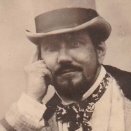
3D printed homes.
Snug Harbor Johnny replied to allanyed's topic in CAD and 3D Modelling/Drafting Plans with Software
They've just tested a rocket engine that was 80% 3D printed ... not sure if I'd want a ride on that. -

Shipwreck of the schooner Ironton found in Lake Huron
Snug Harbor Johnny replied to DelF's topic in Nautical/Naval History
Well, 'treasure/artifact hunters' will have a GREAT deal of difficulty if they want to try and dive at the site of Shackleton's Endurance ... 😉 -
Back in the day when making paper covered rubber powered airplanes on a small bench next to my Dad's (as he made silk covered RC planes), the paper was glued to the fuselage and wing assemblies (pulling reasonable smooth). After the glue cured, all it took was a light spray of water, and the covering dries nice and taut with no wrinkles (if the edges had been pulled smooth when gluing). I flew my planes as-made, but Dad also treated his silk covered planes (once shrunk) with Aerogloss 'hot fuel proof' dope to get a smooth shiny finish that could be wiped clean of any oily exhaust from the single cylinder gas engine that powered the craft. Those were early days, and as time went by a product was developed called Monocote - a special film (a form of shrink wrap) that was glued, then shrunk tight with a hair dryer. No more silk (or stinky dope) after that.
-
I've noted this myself. The cabin walls (and the ships planking also) were thick - for insulation. A fire from inside the cabin does show angles going away from the round port hole frame - so when the time to build comes, I'll do an approximation of this configuration, so from the outside one will see just a round hole in the outer planking, with a round metal frame recessed. There were many stages of outfitting, starting with the original Polaris - then the amount of refitting down in England, of which there are pictures and the OcCre kit is mostly like this version (except that the steering mechanism was not yet inclosed by a small structure (to keep it ice-free). Hence Hake Zou modeled his build with the stern mechanism visible. In South America, the 'Ritz' cabin was enlarged to go forward and join with the central cabin on the weather deck. - as well as adding the ice protection shack over the steering mechanism. This is the version I may do. Once trapped by ice, further modifications were made to set up temporary decking over the stern area (after moving the steering mechanism cover), and there is a version like this displayed (until recently, pending museum upgrades) in the Shackleton Museum in Athy Ireland. One has to sort through all the available pictures to get the proper chronology. There is also a MSW build of a version 'ship in a bottle'. The idea for any ship build is to pick a time, place and situation that one wants to represent ... all ships tended to be 'works in progress'.
-
Wintergreen is right about the 'early days' once the Vasa was raised. I read with interest the National Geographic article (when it came out ... 'showing my age') and the pictures of the hull again in daylight showed that the entire stern had been ripped apart from early 'salvage' efforts - mostly to get the cannon back then, as well as the bow and the decking was gone. So until a 10 year program of stabilization could be complete - and also finding all the broken bits on the sea bottom and preserving them as well - it was anyone's guess as to what the missing portions might have looked like ... perhaps a little like guessing what the Golden Hind looked like, but there was a lot more to go on with the Vasa, and even the Mary Rose. Hmmm, I still think that with modern techniques the British might yet be able to unearth the hull remnants of the GH - thereby at least getting the length, beam, tonnage and lines below the waterline. I'm amazed at how the Swedes have put all the pieces of the 'giant jigsaw puzzle' back together. If I ever win a Nobel Prize (which includes a free trip to Stockholm), a trip to the Vasa museum will definitely be in order ... also with a decent smorgasbord and sauna. Therefore, I do not fault Billings much - and can highly recommend their current Vasa kit. Yes, the carvings are molded plastic, but the detailing is excellent - and plastic can be heated carefully to form as needed before mounting. The Corel kit has metal figures, and I don't think they have near the detail of the ones Billings provides. I compare two other Billings kits - the old Vikingskibbe (1:20), based on Skudelev 5 and the relatively recent Roar Ede (1:25) of the same boat. The old kit was inherited and by examining the materials provided (and a MSW build of the same), the old version is a real challenge. All the parts have to be cut out, the veneers are somewhat fragile and prone to splitting - yet the construction of the bow and stern are done as the original was - built up in successive layers. The new kit, which I have in stash has been adjusted in scale to go with their Oseberg kit (also 1:25 - a kit that has been improved in later releases and also in my stash), is laser cut thin plywood (a real time saver there and the strakes can either be stained OR bonded (before building) with walnut or mahogany veneer (as I intend to do). The new kit does not have the built-up bow and stern, but I saved the parts sheets from the old kit, perhaps to reduce the outlines to 1:25 and attempt to "meld" with the new kit built from contiguous planks. In another post somewhere I compared/contrasted the Scientific Robert E. Lee steamboat wooden kit with the plastic Lindbergh/Pyro kit that turns out to be the SAME scale. Obviously starting with a nice basswood hull is much preferable to a hollow plastic one, and the mahogany stand in the Scientific kit is a nice touch. Still, there are components in the plastic kit that can save time and add detail, such as the boiler and also to have full paddlewheels that spin on an axle (instead of cast metal partial wheel segments). The solid wood stacks are preferable, but the stack top trim (and much other trim) in the plastic kit will be the ones I'll use. Now in the case of the Endurance kit (under $200), just upgrading to brass stanchions and railings would add $60 to the kit price, as more ship-specific fittings would do. Costs associated with greater development time would also have to amortized into the kit price, as would better sails, rope and belaying pins. And OcCre has to consider the kit cost spread offered by their competitors. 'Hard to second guess this, so I can see the logic in selling an adequate kit that can be built 'out of the box' at one skill/experience level - yet still be enhanced by a builder at a higher level willing to make or buy any needed items. Whether I will get to all of the 12 kits accumulated thus far (and I've heard of stashes in the many dozens) before I head out to sea doesn't bother me. If I don't build 'em, someone else will get a chance.
-
Here's a picture of the lantern and flagstaff temporarily mounted. The end of the staff was tapered and grooved for the flag pulleys - the contrast is off with the Admiral's old camera. 'Seems the upper stern of the Vasa has lapstrake clapboards, so I decided to lay on strips of walnut veneer to do this. Again, the overlapping boards don't show well in the image below - but when done and painted they will better conform to the original. The hull is going to be the salient feature of the model when done, so things that will add visual interest and detail may be a plus. The sternmost gun port on the lower gun deck had to be closed off due to where I had to place the lower gallery. But I see that there was a 'communication' port (a little smaller and a bit lower down on the original) for orders, mail and such on the original. So I could place a couple hinges on that cover for effect. After adding clapboard to both sides, I'll put in all those mini brads as previously discussed.
-
'Still shifting focus from place to place on this build - sort of like the eye of Sauron gazing from place to place in Mordor ... I don't want to 'paint myself into a corner' or make subsequent work more difficult by doing the wrong thing first. It also take time to think of the steps to do each small bit - but then once I have a good idea of what it should look like (or thereabouts), it is often a matter of jumping in and improvising as there work progresses - nip and tuck here, correct a couple things there. Apart from previously mentioned shortcomings of the ca. 1970 Billing Wasa (I'll often use Wasa and Vasa interchangeably), if someone obtained an old kit somewhere for a low price (I'm thinking of $100 or so ... a little more if it hasn't been messed with), there is a lot than can be done with forehand knowledge to improve it. Modifying some bulkheads (and redoing a few) plus adding more to conform to the ship's actual lines would be done at the outset. Make partial lower gun decks for low-detail gun carriages drilled to mount half-barrels (the portion that will show from the outside) later - and this can be done on the 1:72 kits available today ... that will look a lot better than the 'false' recesses supplied. Going to double planking will can permit inner gun ports to be cut, then the second (nice wood) planking with width closer to scale will come up just a little shy of these first openings, which is what closed gun port lids would bear against. The biggest challenge is dealing with all the figures and carving at 1:100 scale. This is where the more recent kits excel, and there is also much less to correct. I've ordered a few Kevels, a capstan and some odds and ends from Crafty Sailor. The first picture shows three items. On the left is a reasonably sized stern lantern scrounged form an A.L. parts kit - drilled to accept a steel rod I had on hand, painted, then panels of clear plastic (the sort encasing all sorts of things sold these days - rigid enough but not too thick) were cut with scissors and CA'd as glazing. In the middle is the center support for the flagstaff (shown slipped into the retaining bands) that I will taper on a lathe and turn a little ball on the end. 'Good to have this removable so it won't be subject to breakage as more work is done on the ship. The lantern will go into the small projection at the top of the flagstaff support - an will also be removable (can be glued later). On the right is a test deadeye where I just wrapped soft 24 gauge jewelry wire around, then formed the free end to widen it with a mini ball-peen hammer (planishing face opposite the ball) and drilled for a brad fastener. I note that the deadeyes on the original Vasa are not all that 'triangular', but they are nearly round ... just slightly oblong in the vicinity of the third hole. I wouldn't even call it 'almond' shape. So at 1:100 it might be be OK using round ones - 3mm would be near to scale, but the one shown is 5mm that I have a bunch of. If I were doing a 1:72 version, it would be closer to the original Vasa to abrade a little off each deadeye side to get that slightly oblong look. (I might even do this on mine.) But I would not use the 'obviously triangular' deadeyes that can be purchased (or made). These approximately equilateral triangle deadeyes are suitable for many other early ships, but in the case of the Vasa - not so much ... just saying. The shot below shows the framework in place on the inside of the stern. A close shot shows all the recent filing burrs and slops I've yet to clean up ... all the tiny warts that are hard to see when simply looking at the model on a stand. For these bits it was a matter of cutting small pieces of stock, trial fitting then CAing in place. A daub of accelerator does a nice job of instantly 'locking' the assembly done in a piecemeal fashion.
-
There is a lot of potential for enhancing this OcCre kit, as Clearway has shown on his build log. Many are always looking for more tips and opportunities on any given ship, so more logs can provide this very thing. Best of results, mate ! Johnny
- 183 replies
-
- Endurance
- Shackleton
-
(and 1 more)
Tagged with:
-

Silver soldering
Snug Harbor Johnny replied to Dziadeczek's topic in Metal Work, Soldering and Metal Fittings
Silver soldering is tricky business. I did a few samples in shop class years ago, and the workpieces have to be very clean at the start and well fluxed. We got the heat needed by using oxy/acetylene torches. -
'Just messing around the man cave (aka shop) and thought I'd try an idea I had for making tiny eye bolts from hypodermic syringe needles. I thought they could be useful with the end ground flat to use as tiny gun barrels for the small guns on a Metal Earth U.S.S. Missouri in my stash. But then I was thinking (the Admiral thought she smelled wood burning !) ... what if some material was ground away behind the flattened end, then the 'eye' of the needle lumen of an 18 gauge 'blunt fill' could be bent over to form an eye bolt. A 22 gauge needle fits inside the blunt fill to help keep the eye round when bending. I've got to be careful as I've 'cored' a finger a few times before when working in an I.V. hood doing admixtures - an occupational hazard of a Hospital Pharmacy Technician. The first picture shows the 18 ga. needle. Step 2 is to grind the end flat ... nice for a secondary gun barrel on a warship. Step 3 is to grind behind the end as shown. BTW, the brass 'gall' on the stone wheel is from trimming other stuff. Bending with fine needle nose tended to distort the eye, so the insertion of a smaller needle proved helpful. Clip with flush cutters to separate. This is very tedious and the results are not perfect eyes. There are PE eyes available that will save lots of time and trouble. Also, the needle was not the biggest risk, as iImanaged to grind a bit on one finger. A great thing to put over an open wound is Dura Bond - sort of an artificial epidermis. Dura Bond is waterproof, stays on for days and allows the skin to heal in by 'secondary intention'. Below is a picture with the covered boo-boo. After a while the wound site may appear to 'bubble up' below the Dura Bond - but this is normal and allows healing. Oh, the plastic box lid contains a bunch of really tiny steel mini brads that came with the 1:100 Billing kit. They were supposed to be used for the single planking (yeah, how much did I know about fairing or adding extra bulkheads years ago), but I didn't want to used them. Now I see that the original ship had a lot of iron nails (spikes) used in construction and visible on the outside. Maybe Billings had the right idea with these brads ... but they would be best applied AFTER planking (pre-bending & shaping with glue as the bonding agent like I did it). The 'instructions' could have been a lot better, but what better instruction than to study builds on MSW? OK, so I counted them and found 556 ... plus a few extra that slipped by the tweezers I used to count them all - so the number is more like 560+. So the plan is now to allocate about 250 per side to apply and get an appearance similar to the ship on display in Stockholm (they are replacing the old iron with stainless steel to better preserver the ship). Holes will be drilled so the brads will not split the thin single planked mahogany. My smallest drill (.030) is the same size as the brad shanks, so testing proves that a slightly smaller hole is needed to provide a little interference to retain the brads. A set of 'wire drills' was ordered on Amazon using a gift card left over from Christmas - Fair dinkum ! Johnny
-
I did a VERY small scale U.S.S. Arizona from Metal Earth (completed build on MSW), so working with small, delicate (and losable) bits of metal is appreciated. On the basis of your fascinating build (I'm a Civil War buff), I got this kit to do some time between other projects. (The larger metal Missouri is in my stash as well). Great tip on using CA as required. I found that kneadable JB weld epoxy putty can be mixed in small amounts to stabilize certain parts of a metal build.
-
So I got out those boxed figures to see how I could re-paint them to be approximately OK for my build. On 'old school' hobby shop is still in business in a nearby town - mostly because the son of the owner decided to keep it going as a business ... they have a LOT of 'old stock' as well a new stuff aligned to fantasy gaming. Quite a mixed bag, and these stores are disappearing one by one as Hobby Lobby and other chains become dominant. Still, there are lots of things available on the internet - old stuff as well as new. The picture below shows two groups of HO scale military at attention - all manufactured and painted in Germany - and another group not shown are firemen. 3 figures of this size should stand on either side of the cherubs (or are they putti ?) beside the wheat sheave on the stern. BTW, the babies are naked on the original but I decided to give them loin cloths (diapers ?) for modesty's sake - and didn't want to model little privates for them ... not at 1:100 scale. You know, Steve from down under (aka Louie da Fly) is working on Henry Grace a Dieu where the original was nearly the size of the Vasa ... but in 1:200 scale !!! Size does matter, mate. Now the figures on the Vasa represent Emperors, classical Heroes, fighting men and such ... most with bare arms and legs beyond tunic arms or skirt. So I mixed some flesh color (not too light, since they'd likely have sun tanning) to paint on the figures arms and legs. On the ones with legs close together or relatively close, some gel CA was dolloped to fill the gap and treated with a touch of accelerator to lock in place. Then tunics (hauberks, kilts, whatever) were painted in polychrome - from looking at other builds, a lot of different colors are used - so I let my imagination run wild. Some of the figures stand together on a base, and others have little bases of their own - both fit into a little gap in one half of the box, so it served to hold a group of figures together nicely. I held onto the plastic box half with one hand and painted enamels with the other. The finished HO figures are pictured below, and they may be good enough to pass on the model. Then I had to paint the N scale (N-gauge RR) figures that go in various places around the stern. That was finicky, but then there are some Z scale figures that go at the bow - one of them (as yet unaltered) can be seen in the shot of the N scale figures below. I won't mount any of them just yet because there are a lot of things to do that require manipulation of the hull. Have to think of the 'order of assembly' - which things to do first to make later progress easier. So we'll see how long it will take me to 'putter through' all that.
-
Hello again, The cupolas were glued in place (titebond) and I cut some balsa 'filler' to serve as a support for the roof clapboards that need to go on. Another approach might have been to make small frames, then plank them - but the balsa was handy and won't show. The planking with mahogany veneer was a little fiddly in places - as it was doing the cupolas. I started using aliphatic resin, a 'go to' glue for wood-to-wood applications - but it takes a few minutes to 'grab' and I found myself using 'finger clamps'. Still, the smaller pieces for the end of the upper gallery would tend to move, and before installing the next row in any case - I had to let the glue cure at least an hour because some trimming and cleanup was needed before moving on. OK, so I thought I'd try using gel CA which bonds much quicker. (Note that even dry wood has some moisture content that aids in CA bonding.) Once positioned, a dauber was used to transfer a very little 'accelerator' to the edges of the last clapboard glued ... and there was an almost instantaneous solidification of the CA. I could do trimming, filing sanding right away. I know of recent CA discussions on the site, but there are some times when it comes in handy, as there are times I used 2-part '5 minute' epoxy and even kneadable epoxy (JB) as a filler. 'Guess its a matter of whatever works for the builder. Anyway, the roofs are done and I applied some flat acrylic paint ... and things are looking ever more 'Vasa like'. I glued in the turned brass half-cannons astern for the picture this time. It occurred to me that the somewhat larger (and improved) Vasa kits sold these days have all the small figures of various sizes needed to decorate the places on the ship where ornate carvings were used. What I've done so far was hand-sculpted and tedious, and the process of making the many dozens of various kinds of figures, etc. is daunting. The approach will be to use some HO and N scale molded military (among other) figures re-painted to look more like Emperors or whatever, then bond them around the stern roughly where they appear on the original. This leaves something to be desired (as often happens), but at 1:100 they should be adequate - and certainly better than nothing.
About us
Modelshipworld - Advancing Ship Modeling through Research
SSL Secured
Your security is important for us so this Website is SSL-Secured
NRG Mailing Address
Nautical Research Guild
237 South Lincoln Street
Westmont IL, 60559-1917
Model Ship World ® and the MSW logo are Registered Trademarks, and belong to the Nautical Research Guild (United States Patent and Trademark Office: No. 6,929,264 & No. 6,929,274, registered Dec. 20, 2022)
Helpful Links
About the NRG
If you enjoy building ship models that are historically accurate as well as beautiful, then The Nautical Research Guild (NRG) is just right for you.
The Guild is a non-profit educational organization whose mission is to “Advance Ship Modeling Through Research”. We provide support to our members in their efforts to raise the quality of their model ships.
The Nautical Research Guild has published our world-renowned quarterly magazine, The Nautical Research Journal, since 1955. The pages of the Journal are full of articles by accomplished ship modelers who show you how they create those exquisite details on their models, and by maritime historians who show you the correct details to build. The Journal is available in both print and digital editions. Go to the NRG web site (www.thenrg.org) to download a complimentary digital copy of the Journal. The NRG also publishes plan sets, books and compilations of back issues of the Journal and the former Ships in Scale and Model Ship Builder magazines.



